Devotion – Part 1: Myanmar
Chapter 4: Kalaw, Inle Lake and Indein
From Bagan we flew to Heho, the closest town to Kalaw with an airport, where we were starting this part of our journey. Our driver and guide easily identified us at this small airport and drove us to Kalaw, a small and attractive community that is known as the starting point for hikers wanting to trek the Shan Plateau. In Kalaw we stopped at a large terrace with numerous pagodas. I knew by then that a place with so many pagodas was likely exclaiming “this is an important place.” We had arrived at Shwe Oo Min Paya. Perhaps the white elephant statue could have been a clue about the significance of whatever it was that was still out of sight? (White elephants are very important in Southeast Asia. I will tell you more about white elephants when I take you to Thailand.)
What was important at Shwe Oo Min Paya was below ground. We walked through a small opening, with a low ceiling of jagged rock, down narrow steps into a natural cave. The cave was narrow throughout and somewhat meandering. It was chocked full of Buddha images. When I say chocked full, I mean it. The cave at Shwe Oo Min Paya houses more than 8,000 Buddha images of various shapes and sizes. The populating of Buddhas started centuries ago by local pilgrims; more recently images were donated by Buddhist organizations from as far way as Singapore, the Netherlands and the United States. Walking a narrow passageway, underground, with a string of light bulbs illuminating countless Buddhas at several levels on both sides of us, was a bit surreal.
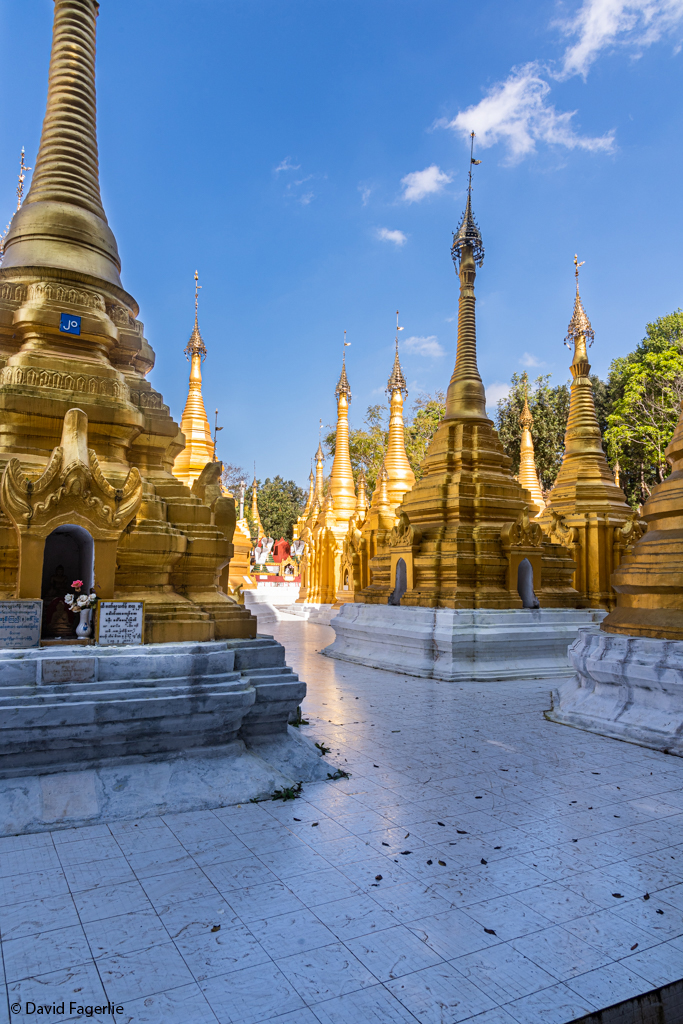
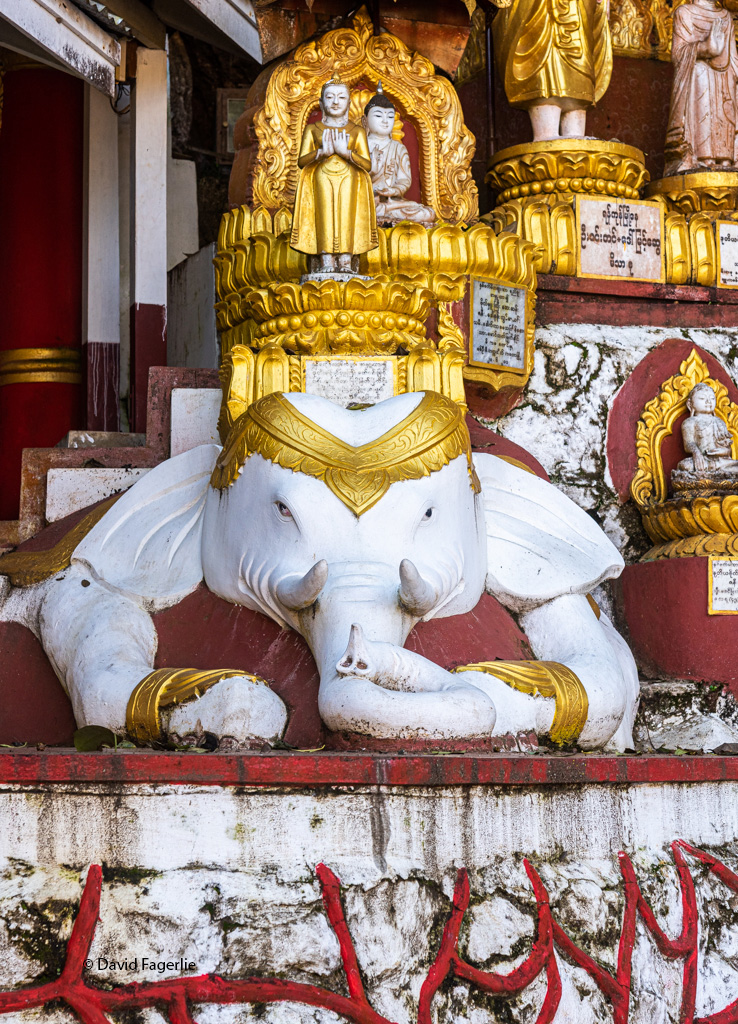
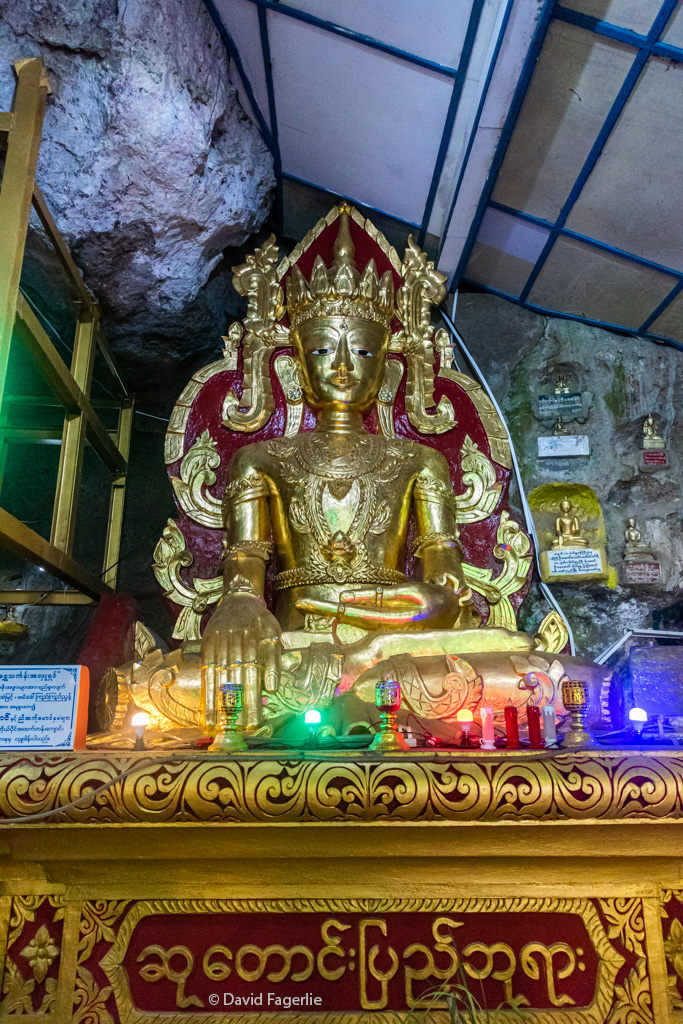
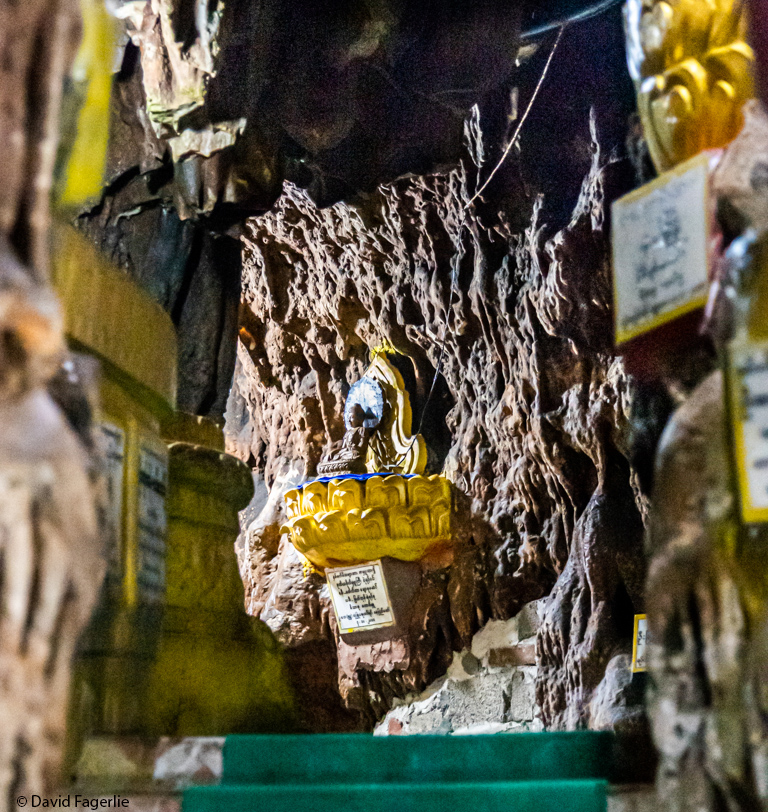


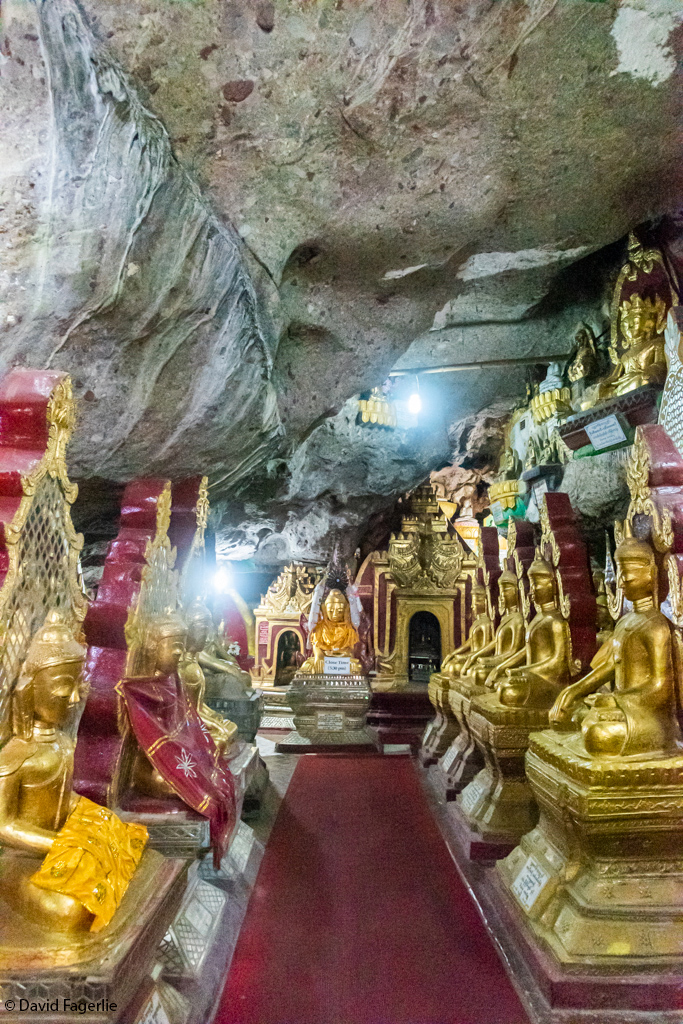
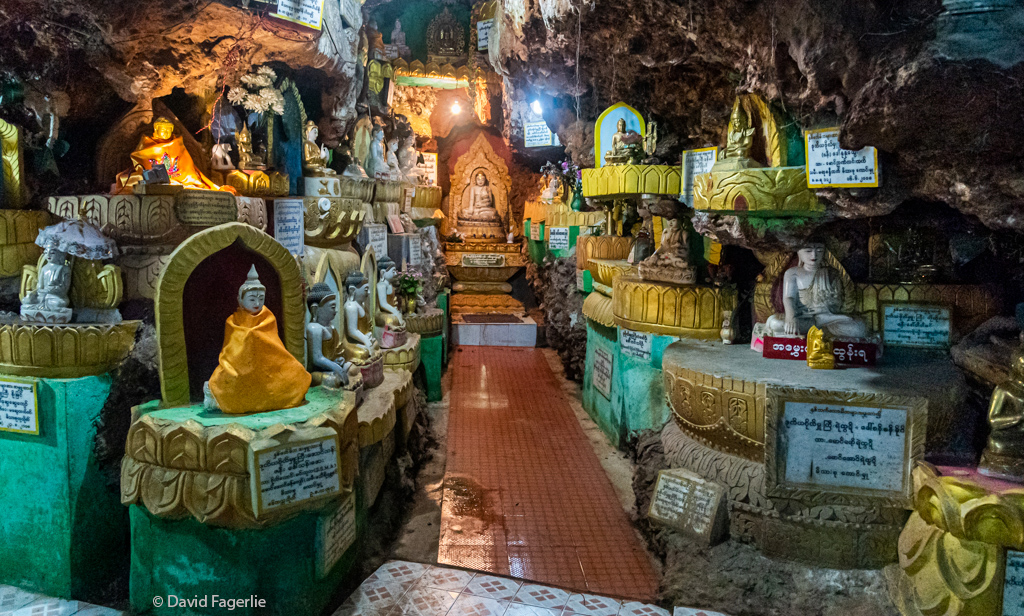
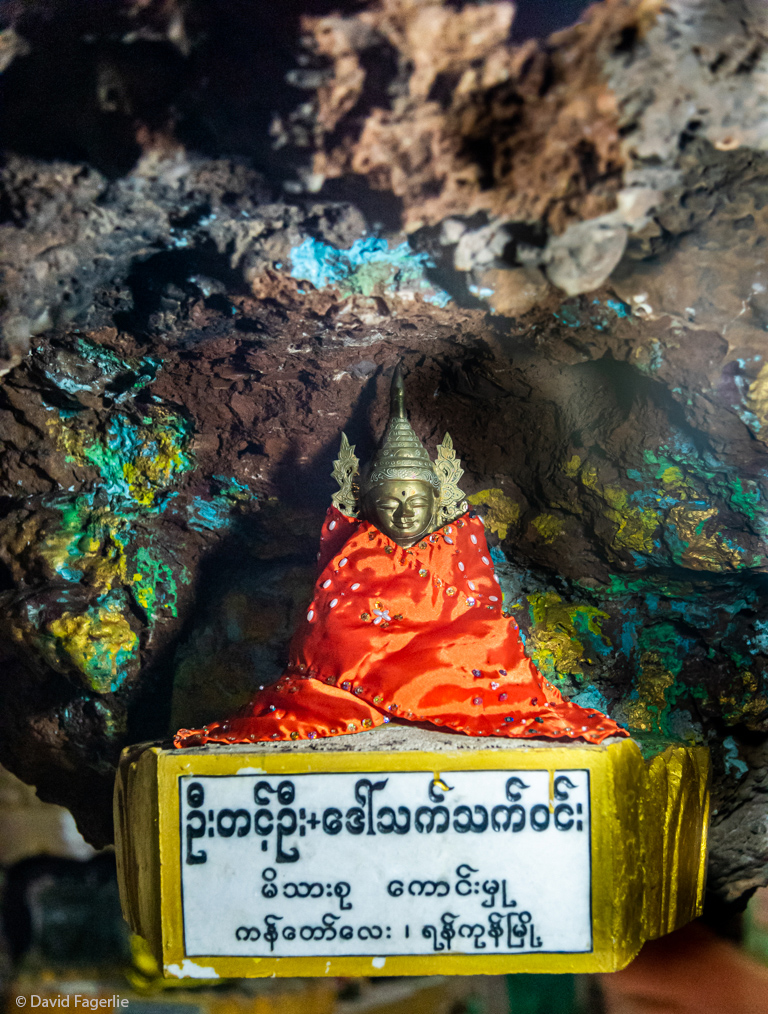
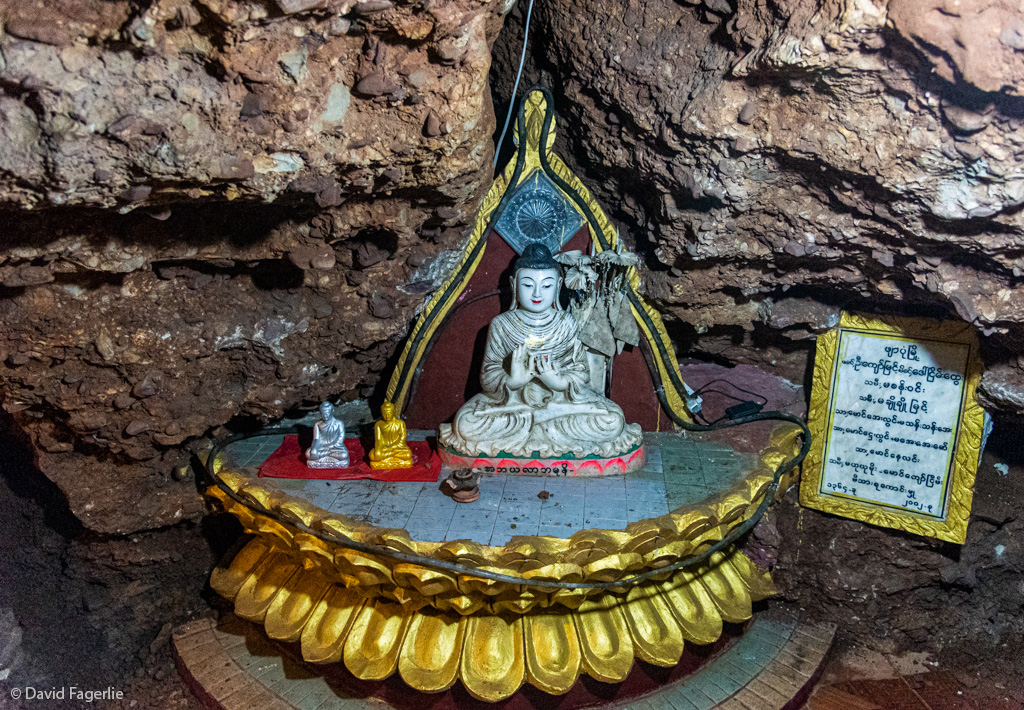
After a night in Kalaw, we visited an elephant sanctuary. The following day we were off to the lake, which was only fifty kilometers away.
Inle Lake is at an elevation of 880 meters in central Myanmar just southeast of the center of the country. It is large (116 square kilometers) but shallow. In the dry season the lake is about 1.5 meters deep but rises to about 3.7 meters during the monsoon season. The lake is rich in water life including more than 35 species of fish and 45 species of freshwater snails. Large sections of the lake are covered with floating plants. Inle Lake is within a wetlands sanctuary of 533 square kilometers.
Our driver dropped us at the head of a canal in Nyaung Shwe, near the very northeast corner of Inle Lake. A boat and boatman were waiting. The boat was just wide enough for one person to sit in a seat. The seats were arranged in a row and mounted to the floor. The seats had back supports. Made of wood and painted blue, the seats reminded me of wooden lawn chairs. There were four “lawn chairs” for the four of us. The boatman and our guide had working space at the stern of the boat just in front of the motor.
The boatman powered up the motor and we were off to begin our journey into a new world. The boat was powered by a large motor turning a long shaft ending with a large propeller. The drive shaft was attached to an ingenious mechanism that enabled the boatman to move the propeller up, down and side-to-side. Our boat was identical to this one. It had plenty of get-up-and-go.
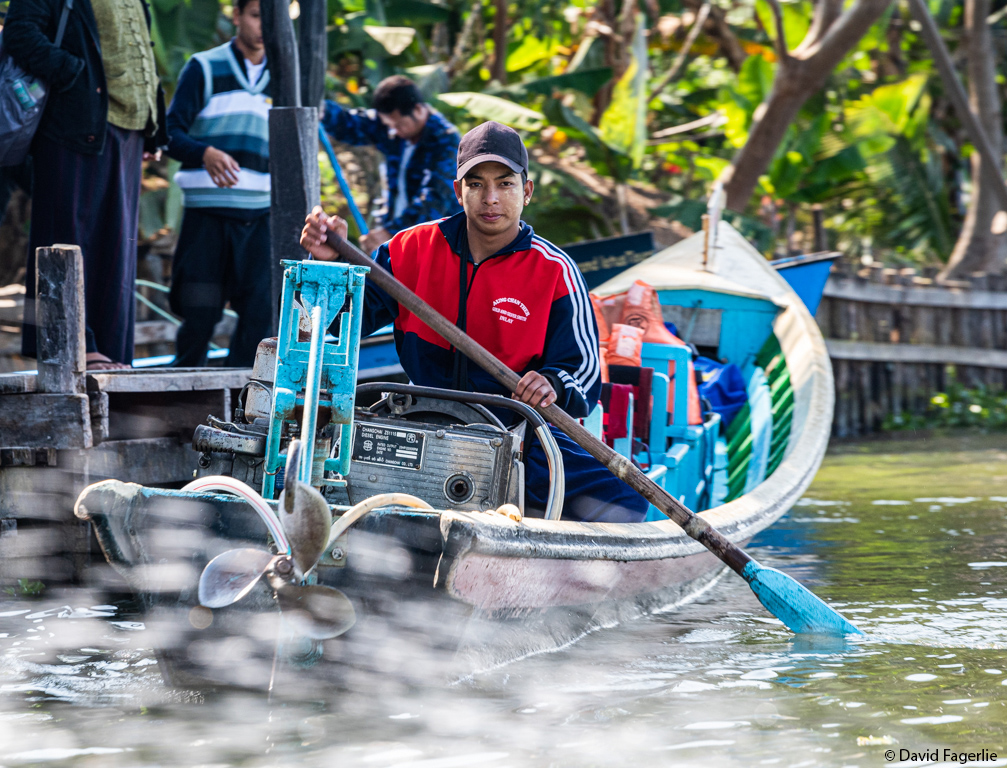
After entering the lake from the canal we were soon passing fake-fishermen demonstrating the unique fishing procedures of Inle Lake, hoping for tips; we passed them by. Not long after, the real fishermen and harvesters of floating plants appeared, standing on the far end of even narrower wooden boats with no seats. Some of the boats were powered by a small outboard motor with a long driveshaft. Typically, the drive shaft and propeller was turned 180 degrees on the motor’s pivot and resting in the boat while a fisherman was working.
Boatmen of Inle Lake are famous for their method of navigation that tourists travel to the lake to see. They balance, seemingly without effort, at the end of a boat, on one foot. The hand hold of a paddle is tucked in the opposite side arm pit and the foot on that side, curled around the shaft of the paddle, does the work to move the boat about, leaving both hands free to operate one’s tasks. The plants harvested are used as fertilizer.
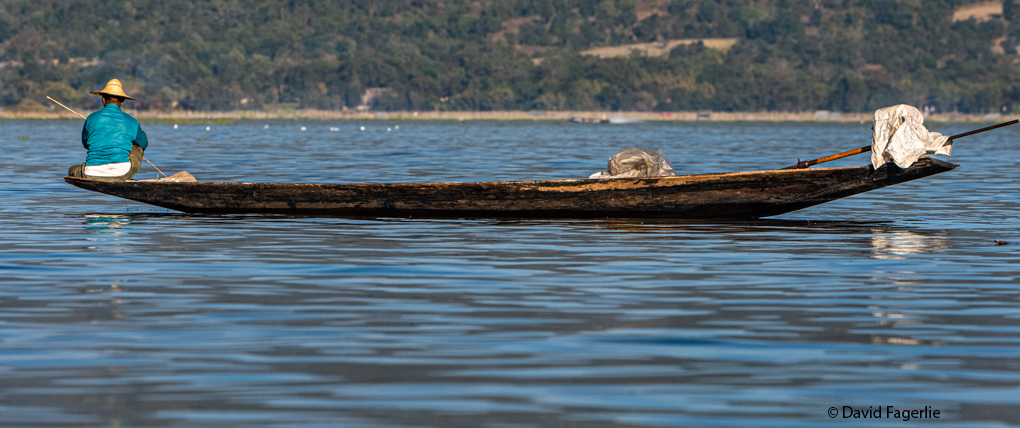
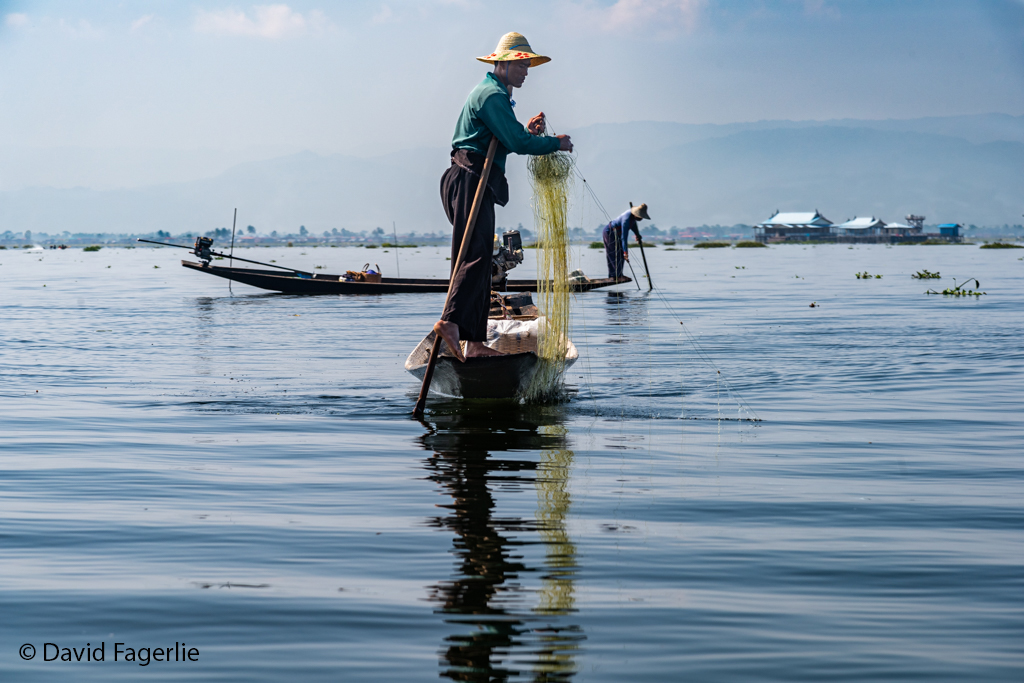
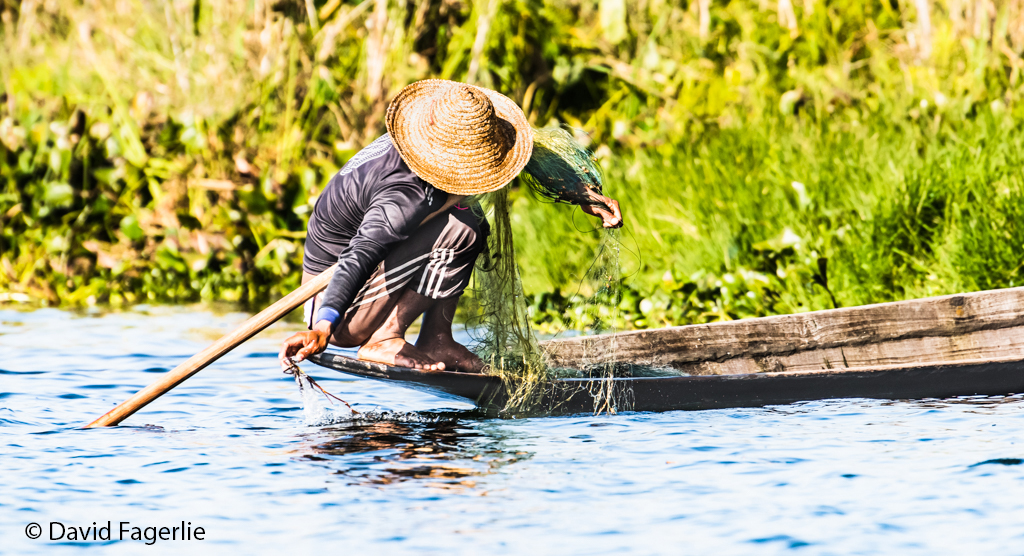
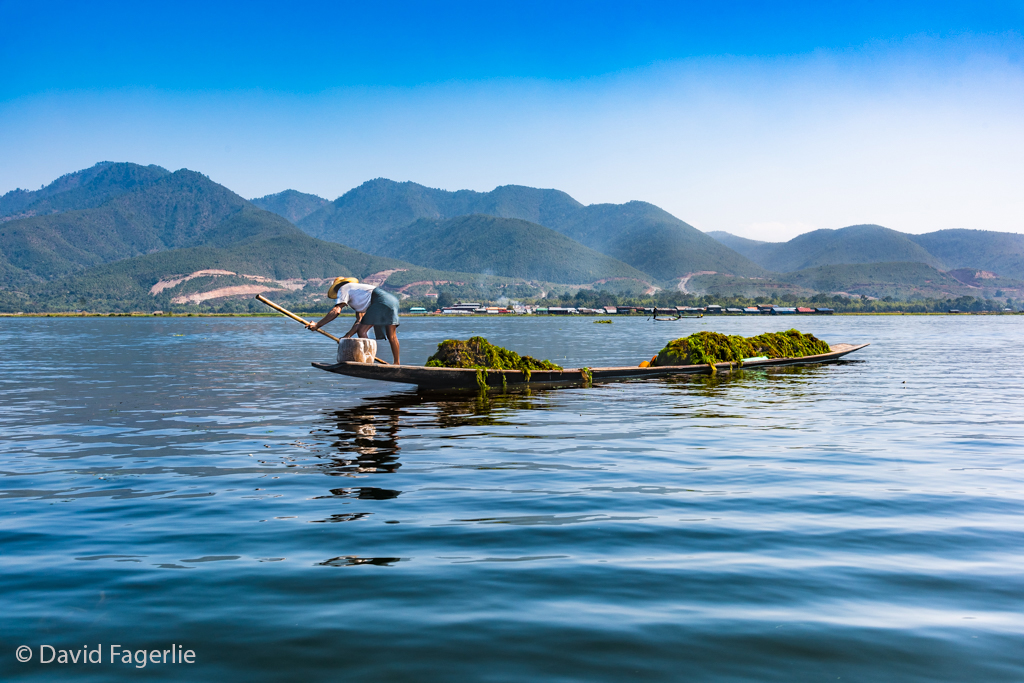
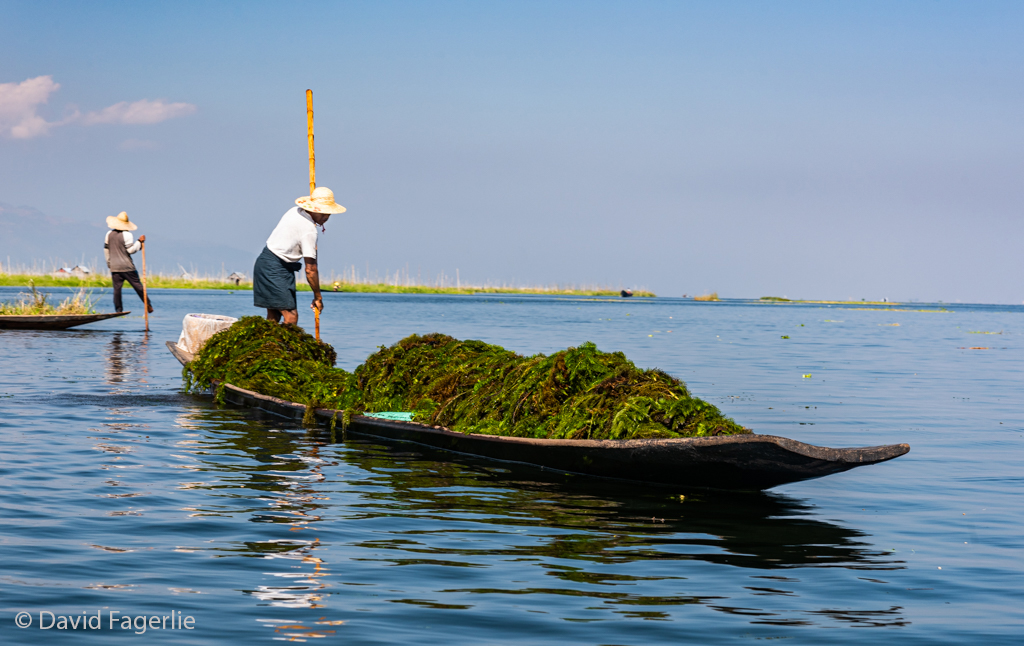
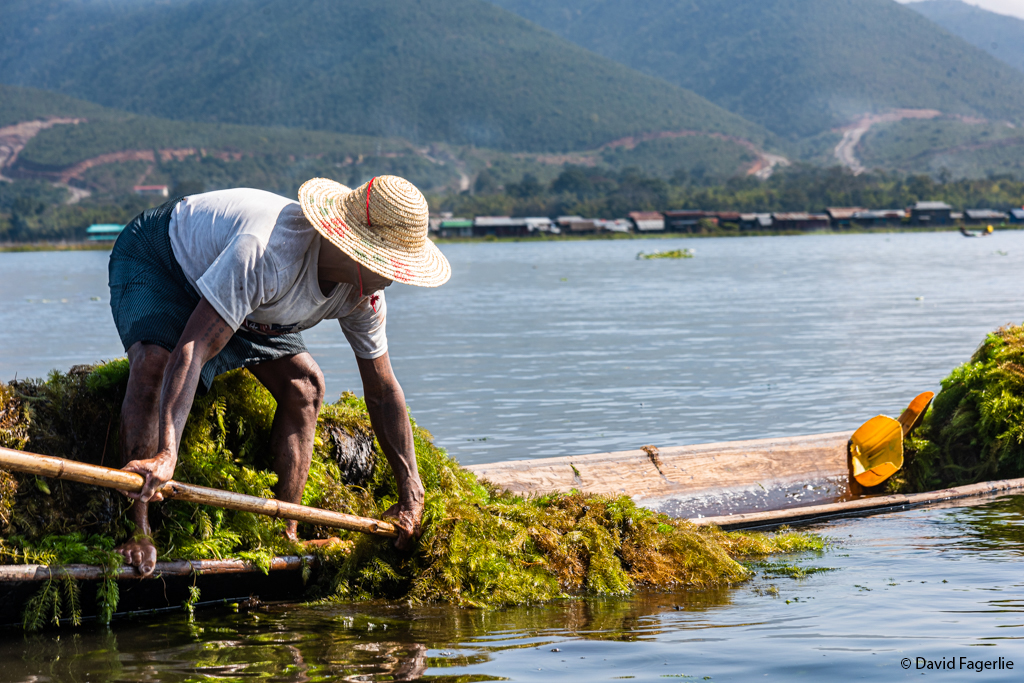
Our hotel on the lake was more of a large resort with single-story hotel buildings and more expensive cabins. It was a pleasant place to stay. When we departed by water for a day trip, the channel inside the resort property was smooth like glass. It was easy for our boatman to weave about until we could sail through a gate, that could be locked, into the open lake. The lake also was smooth like glass and peaceful but for the sound of our boat motor and other boats that past us while conducting commerce.
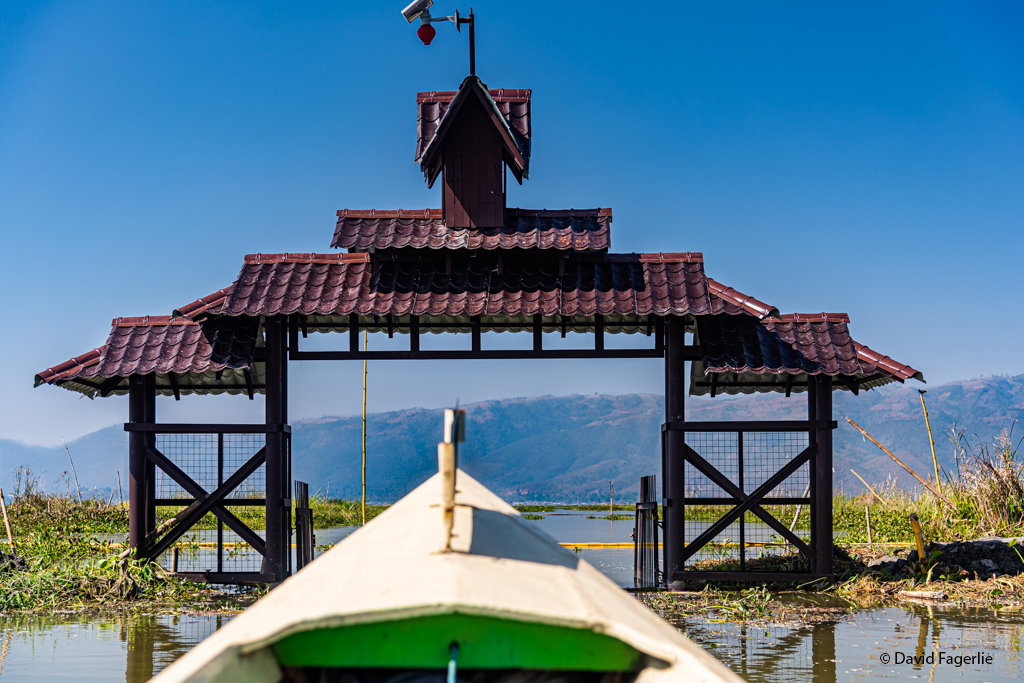
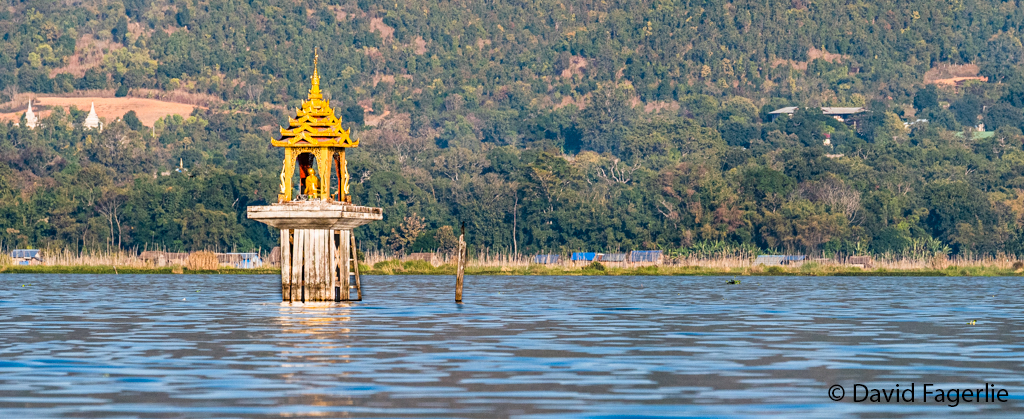
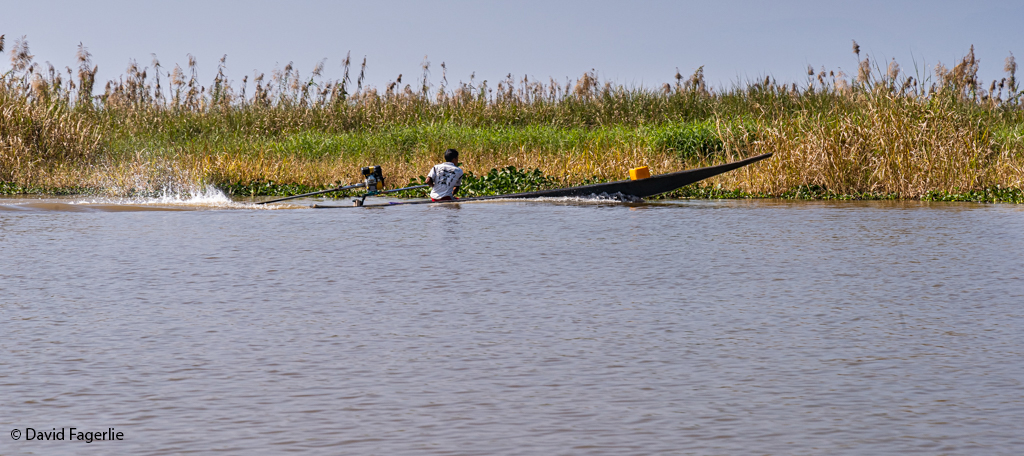
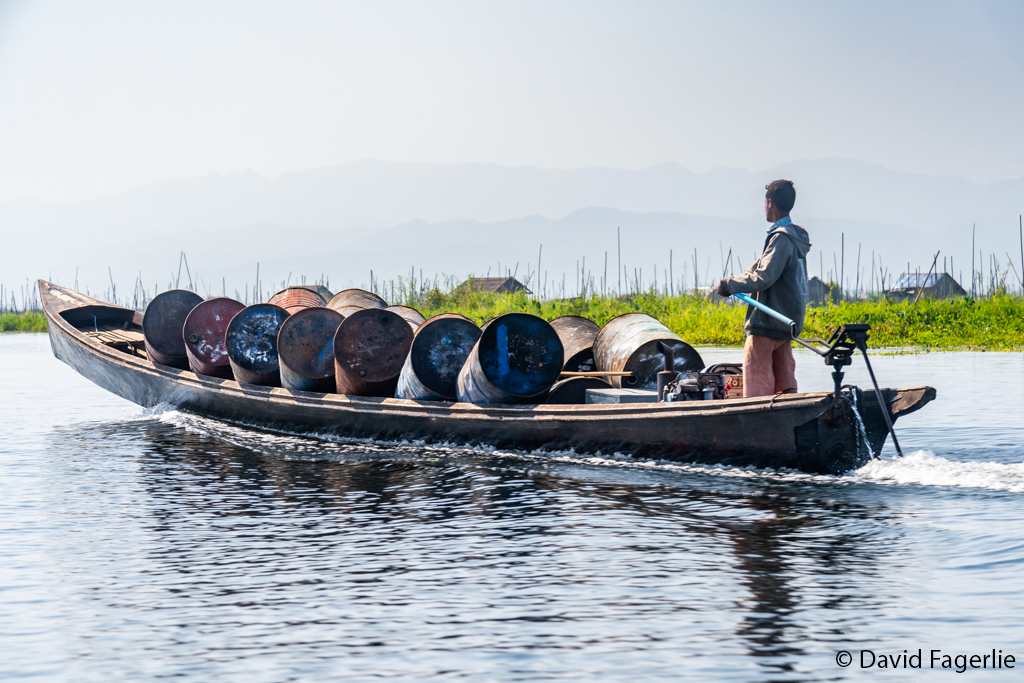
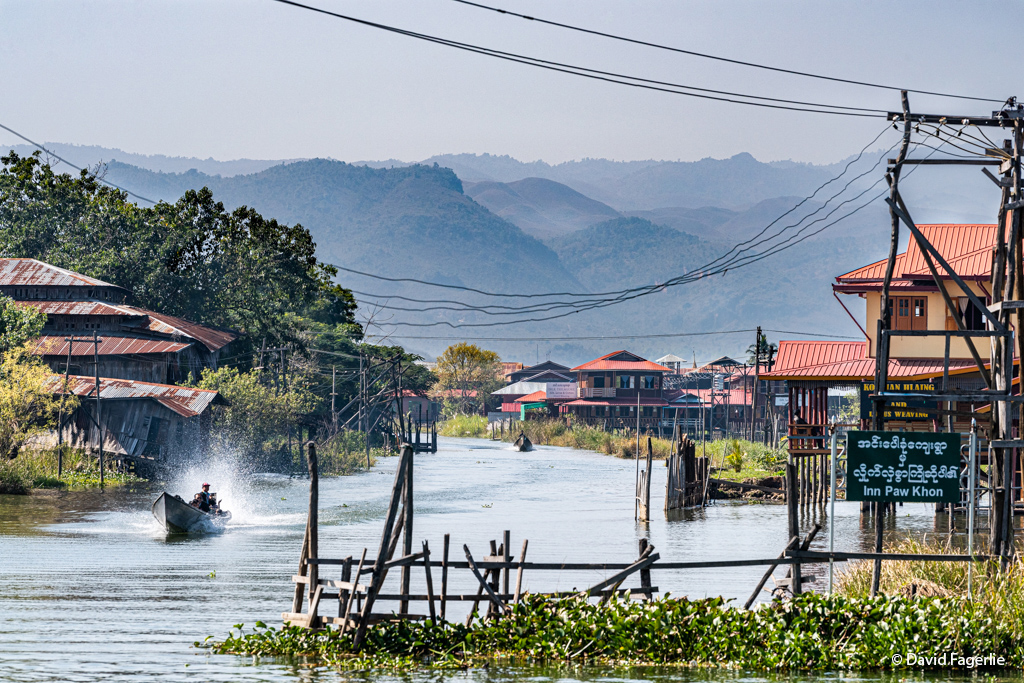
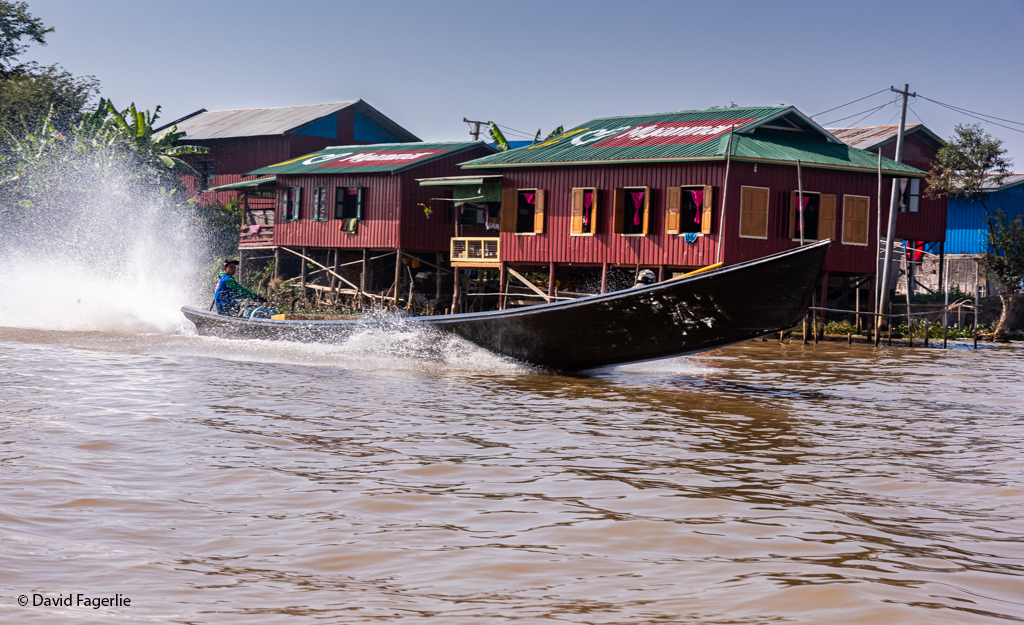
As we traveled across the lake communities started to appear on the water. Homes and businesses, built on stilts, were connected to each other by the lake. Transportation included paddle boats for those going a short distance within the community or power boats if traveling further or shuttling goods. Our boat worked its way around floating gardens held in place by long poles. We passed houses, businesses and even platforms of cattle on top of wooden stilts with the lake underneath them. The community we had entered was quite active. Boats were heading in all directions. Most boats were narrow and wooden, typically without seats. Some of those boats had platforms that would keep one’s bottom and any cargo dry if water splashed into the boat and slipped below the platform. Some boats had round mats, woven from hemp, to cushion a person from the hard wood.
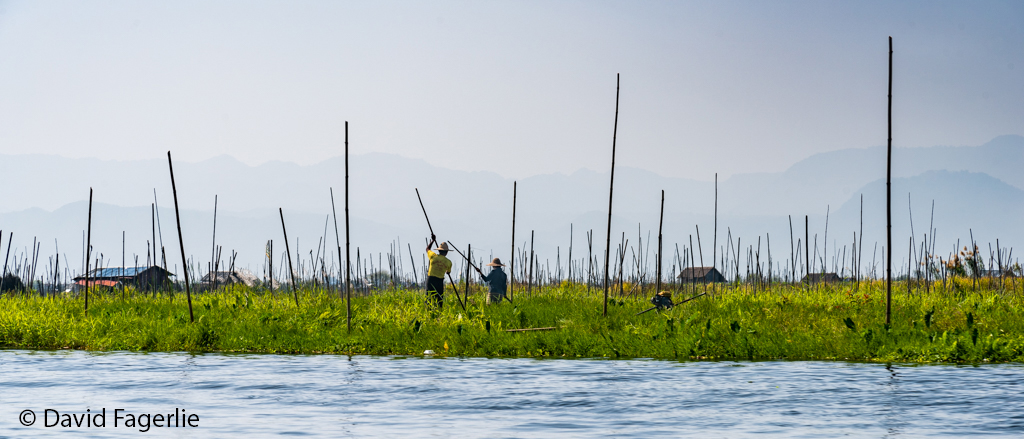
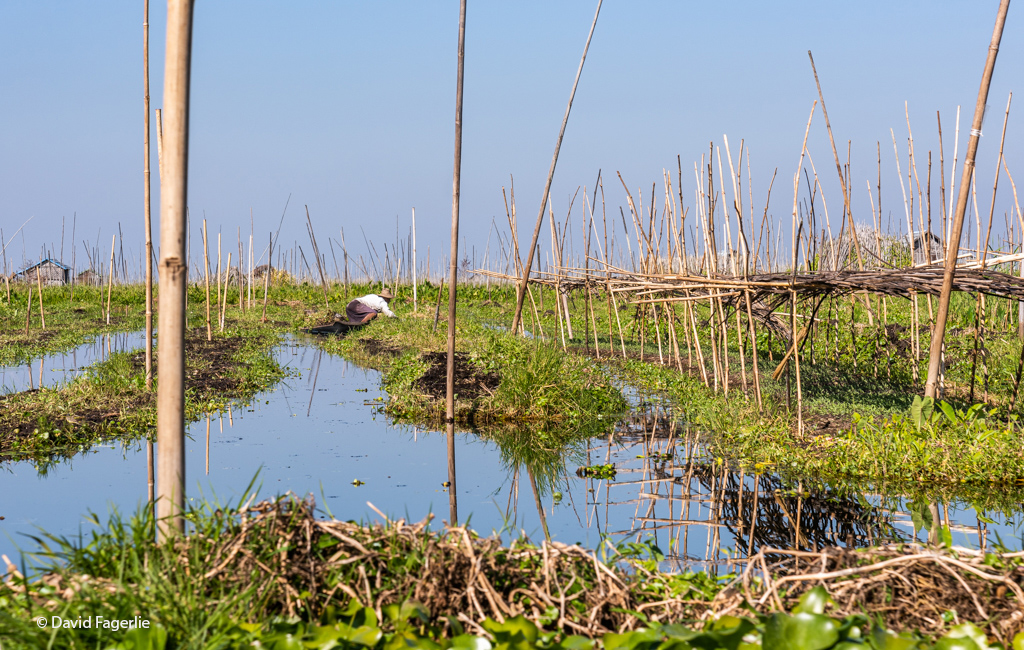
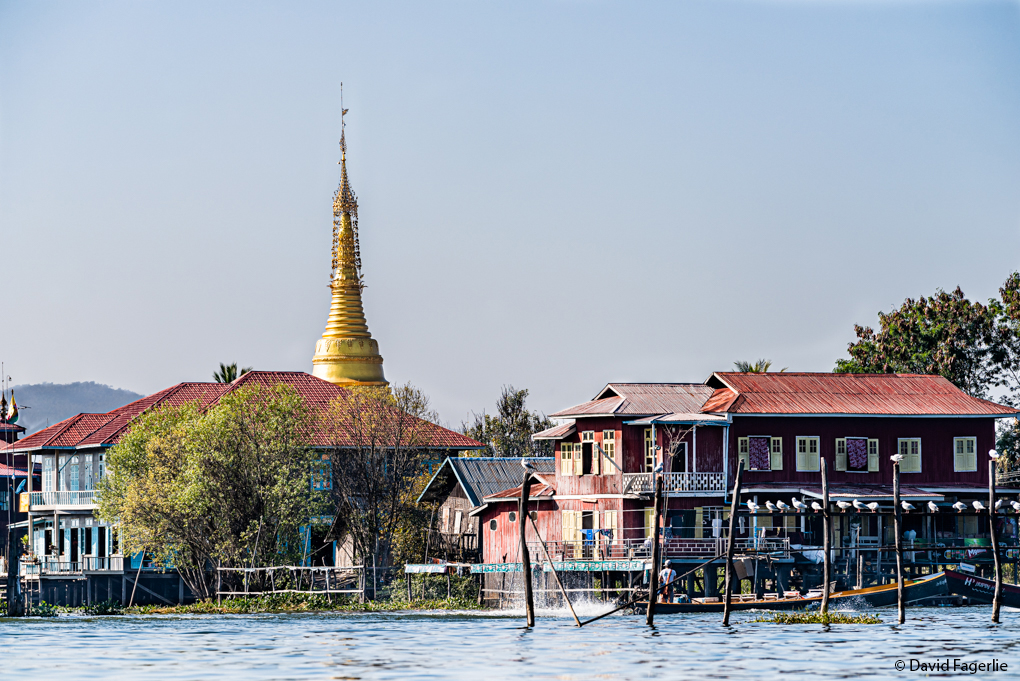
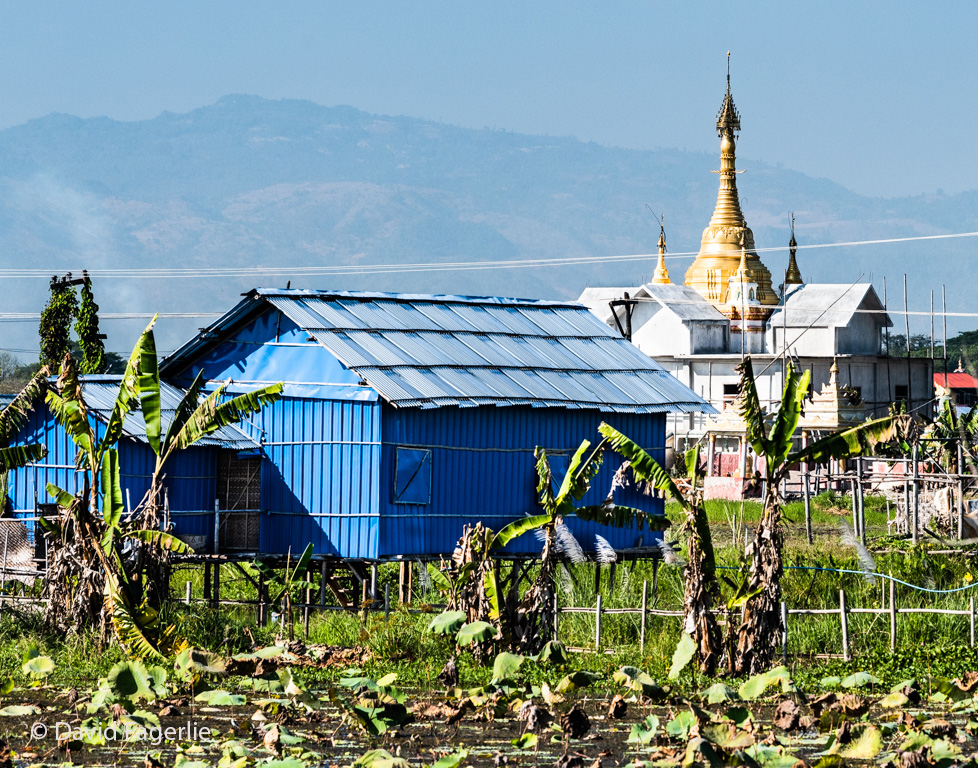
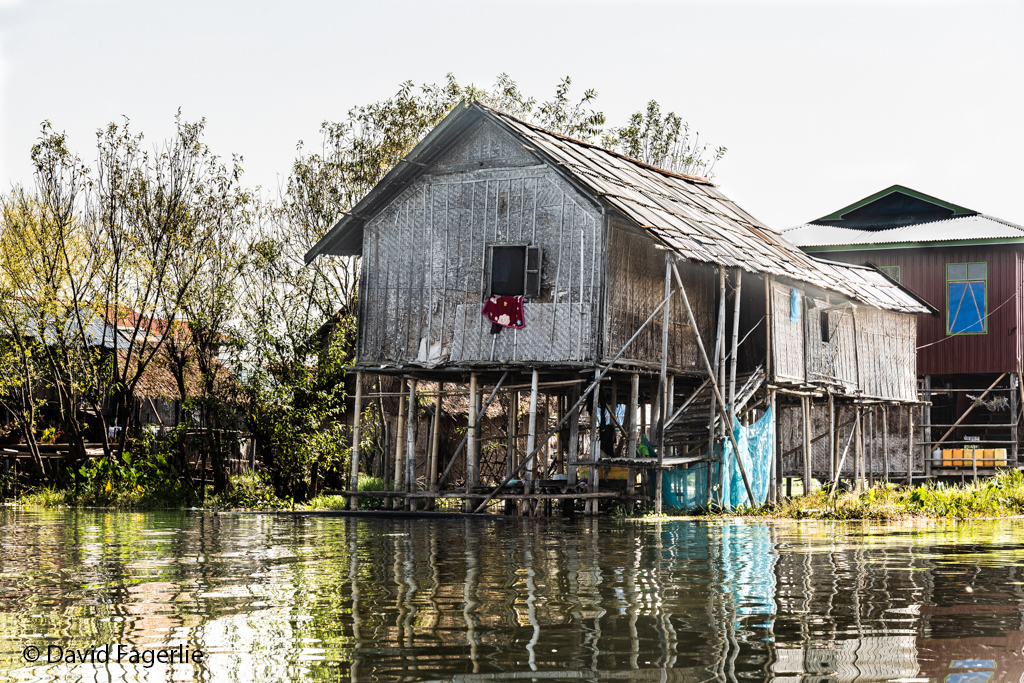
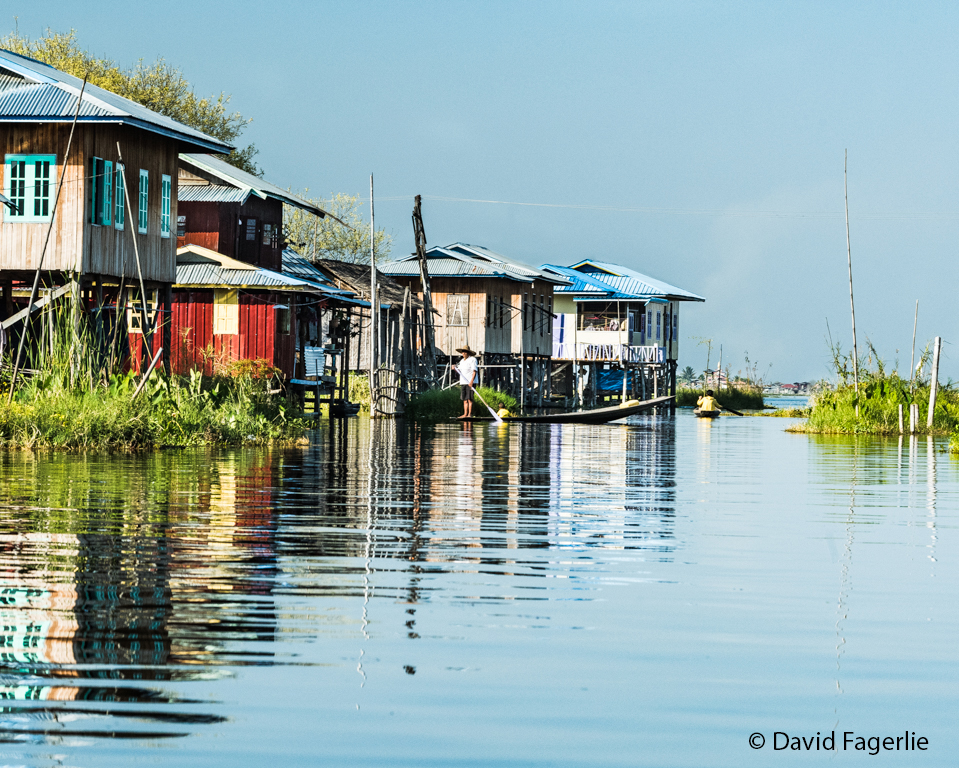
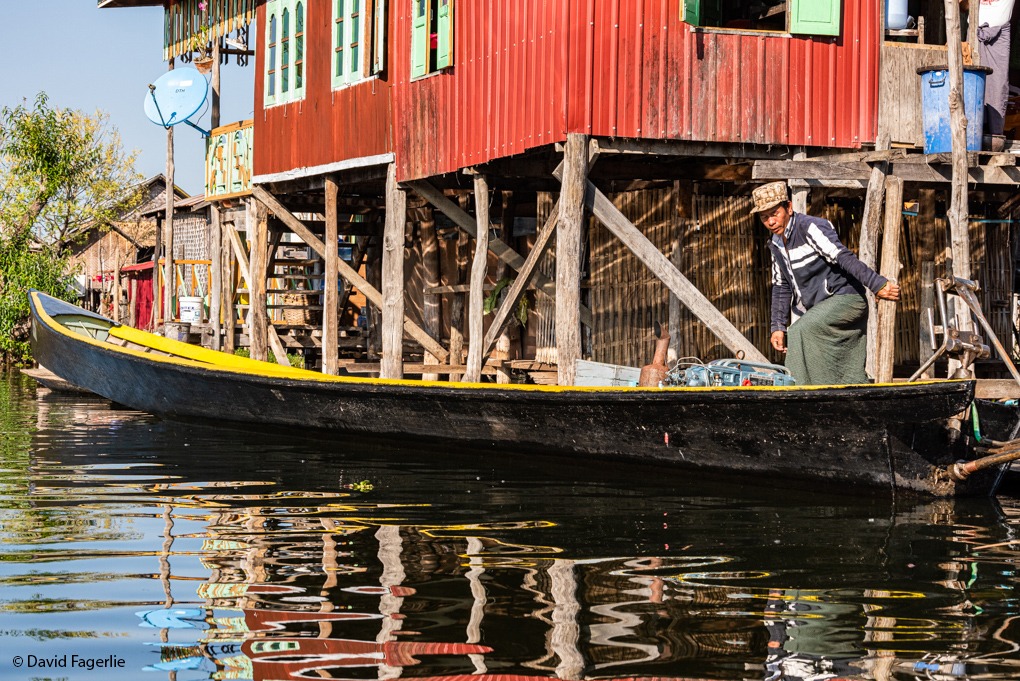
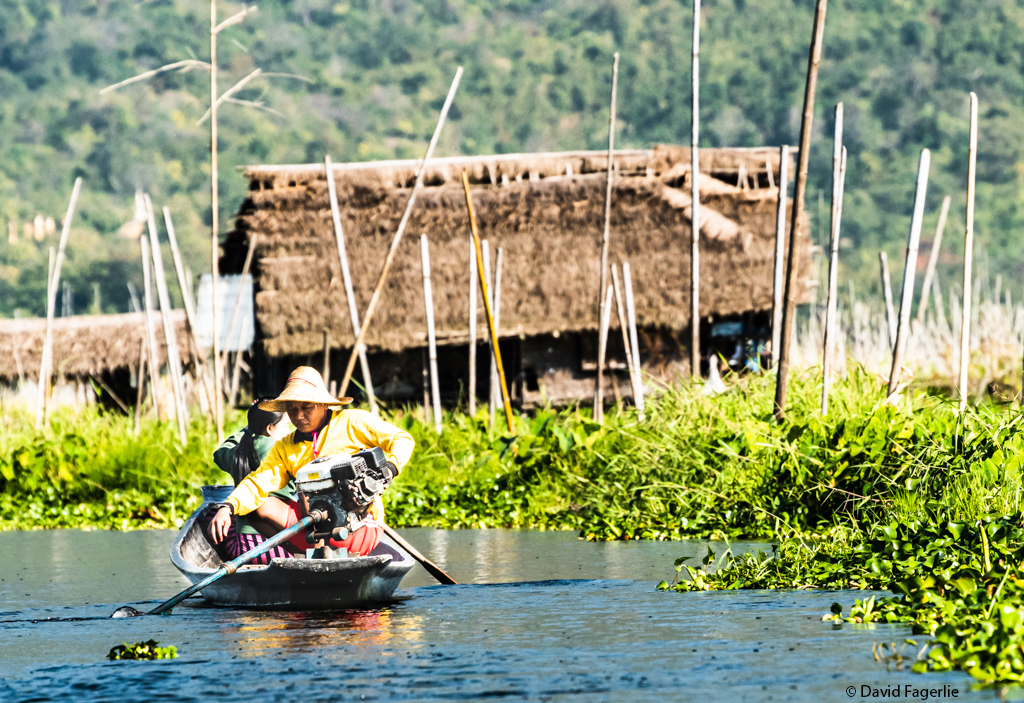
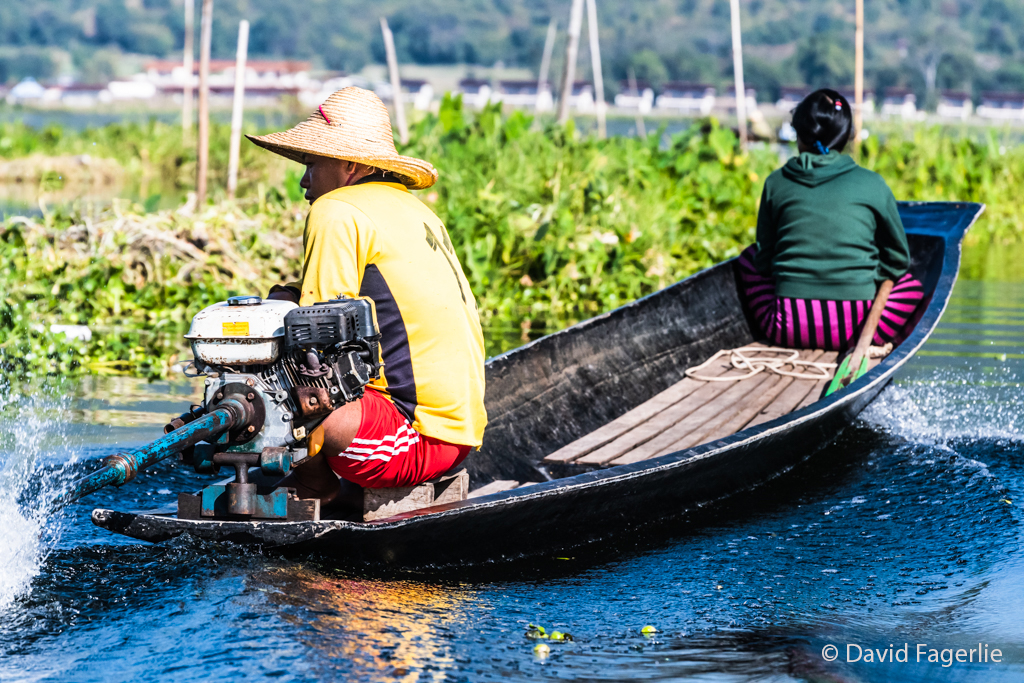
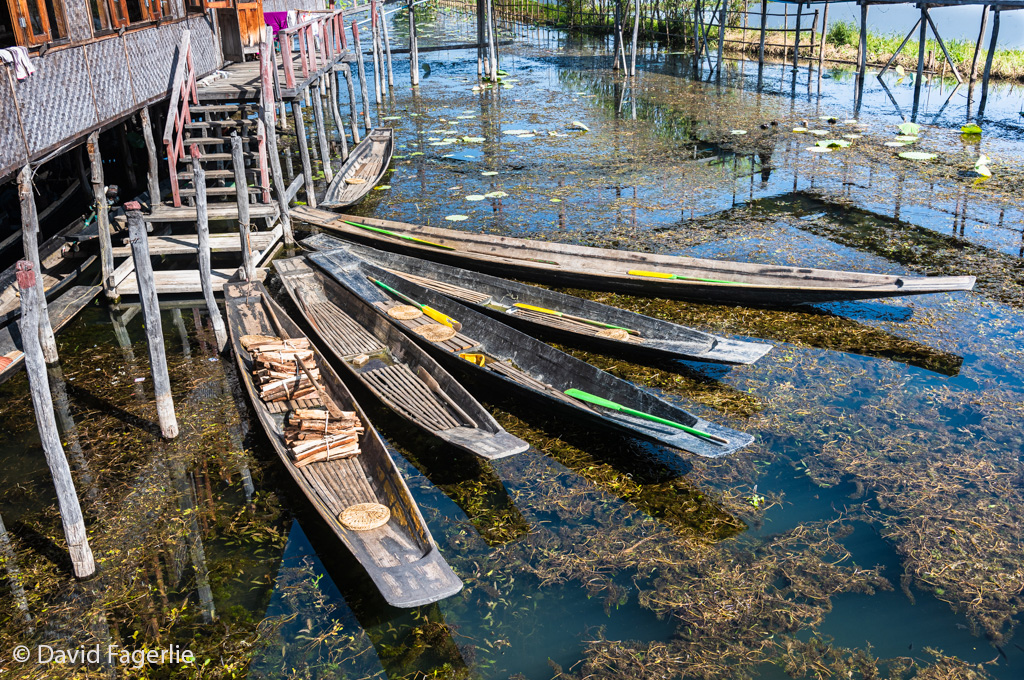
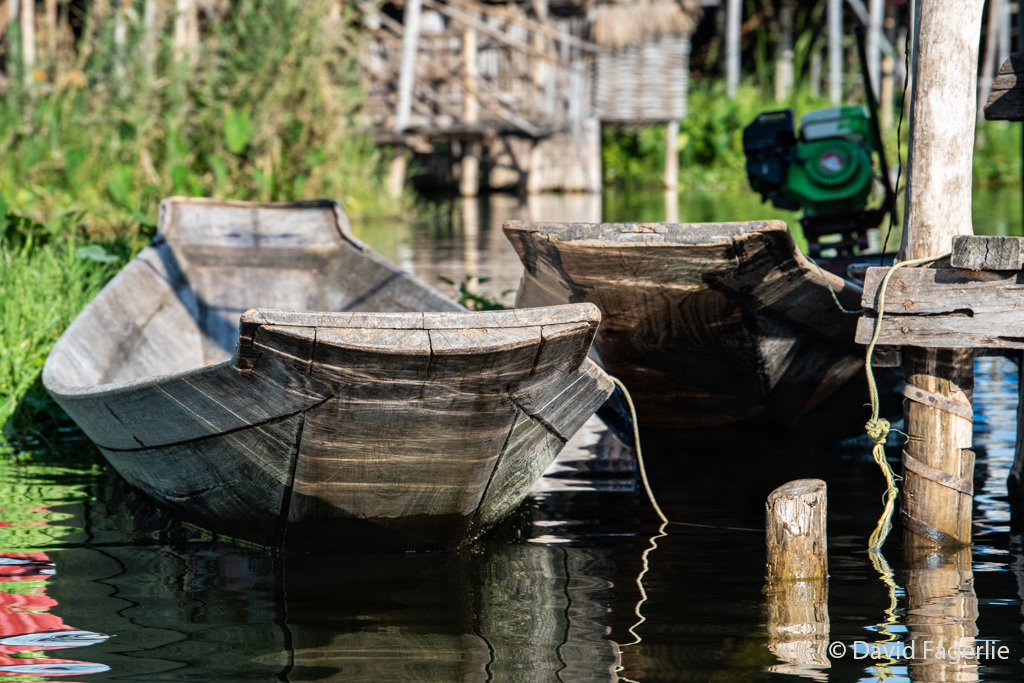
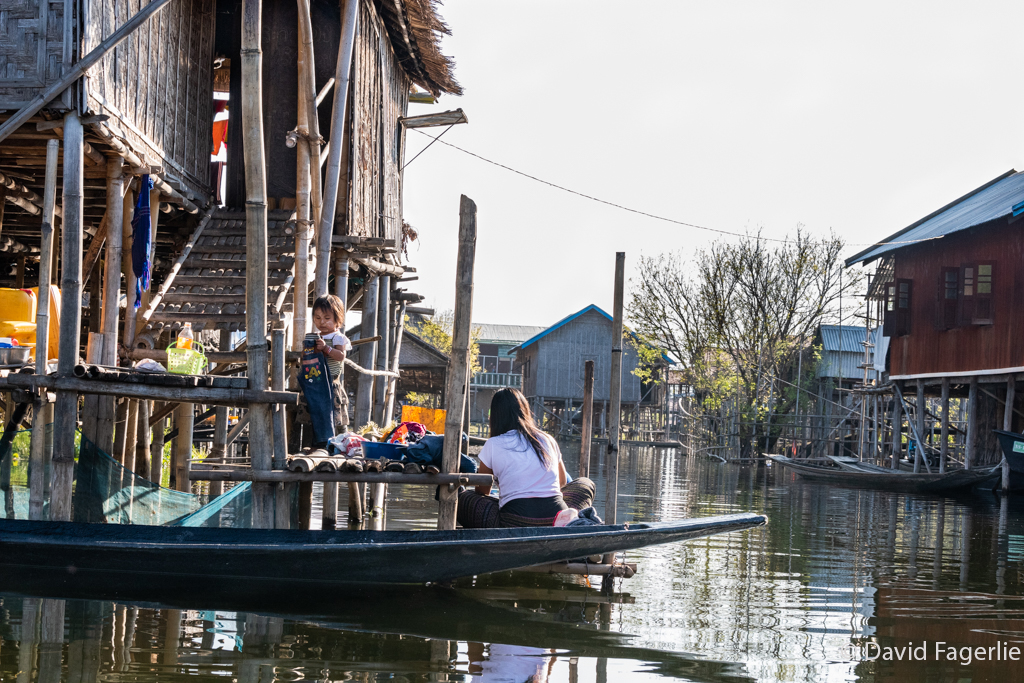
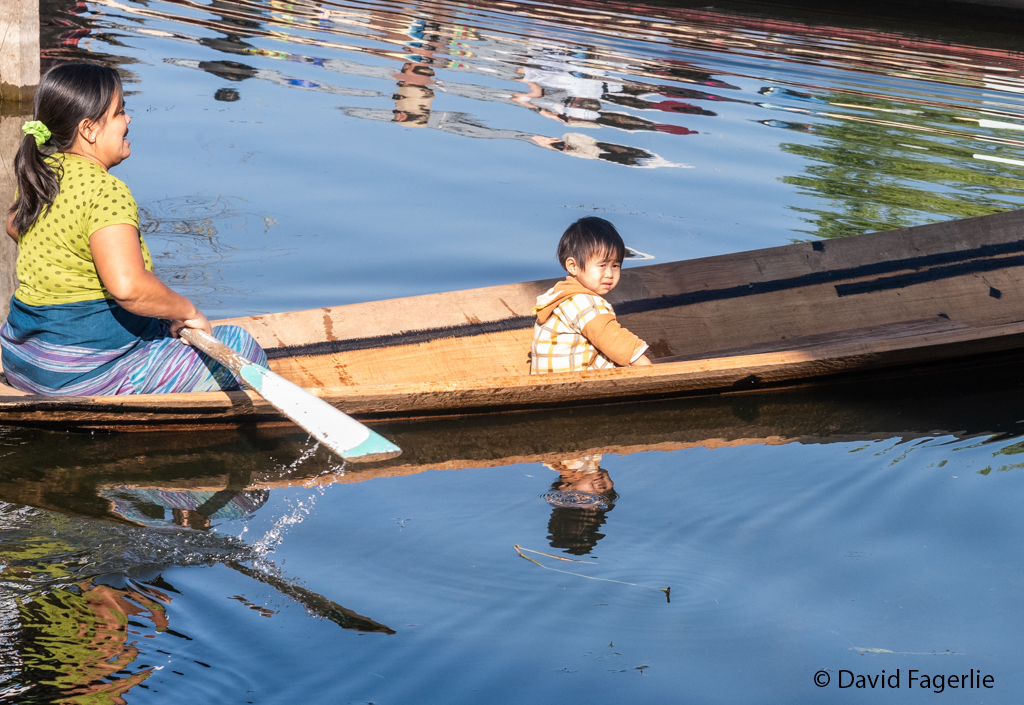
There are many villages on/above Inle Lake. There are also four larger towns on the shoreline around the lake. Among the businesses around the lake included silk weaving, thread making from lotus plants, boat making, gold and silver smithing and jewelry making, paper making, and even a blacksmith. There is on-shore farming of crops such as peppers and soybeans that are processed into tofu and soy cakes. The soy cakes are dried in the sun then sent to markets, mostly in Mandalay. Cigar making is a thriving business.
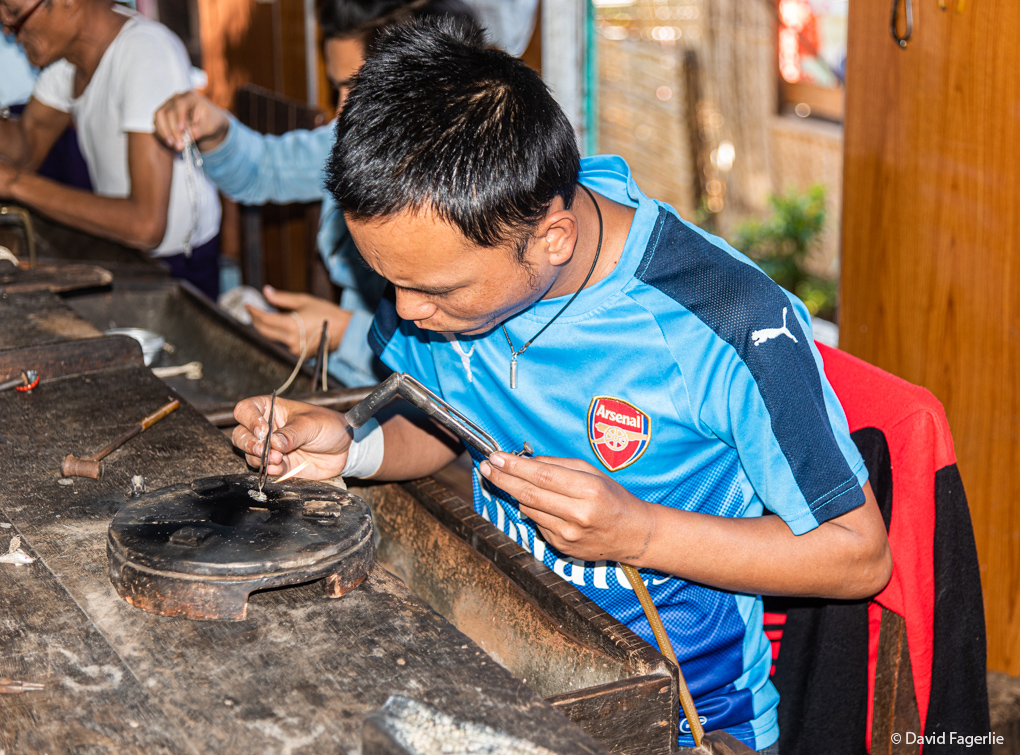
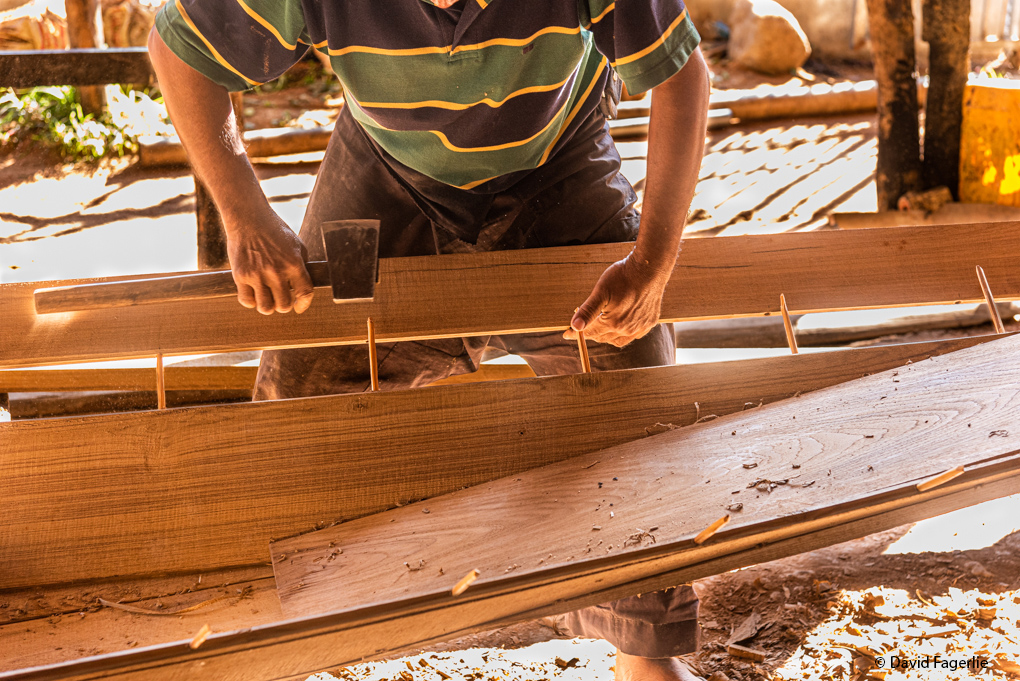
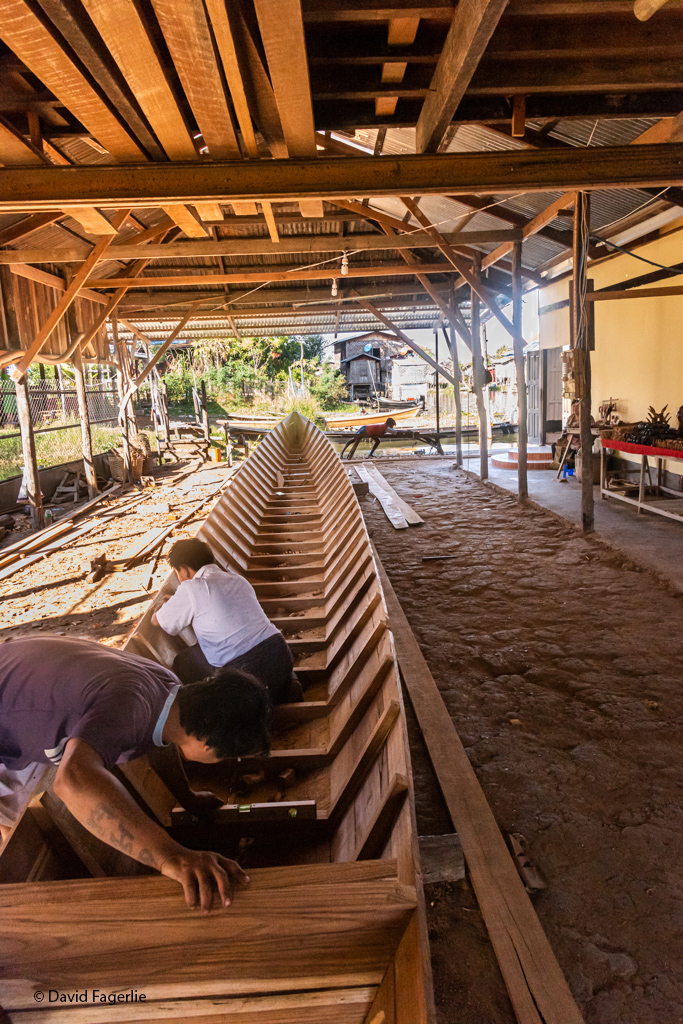
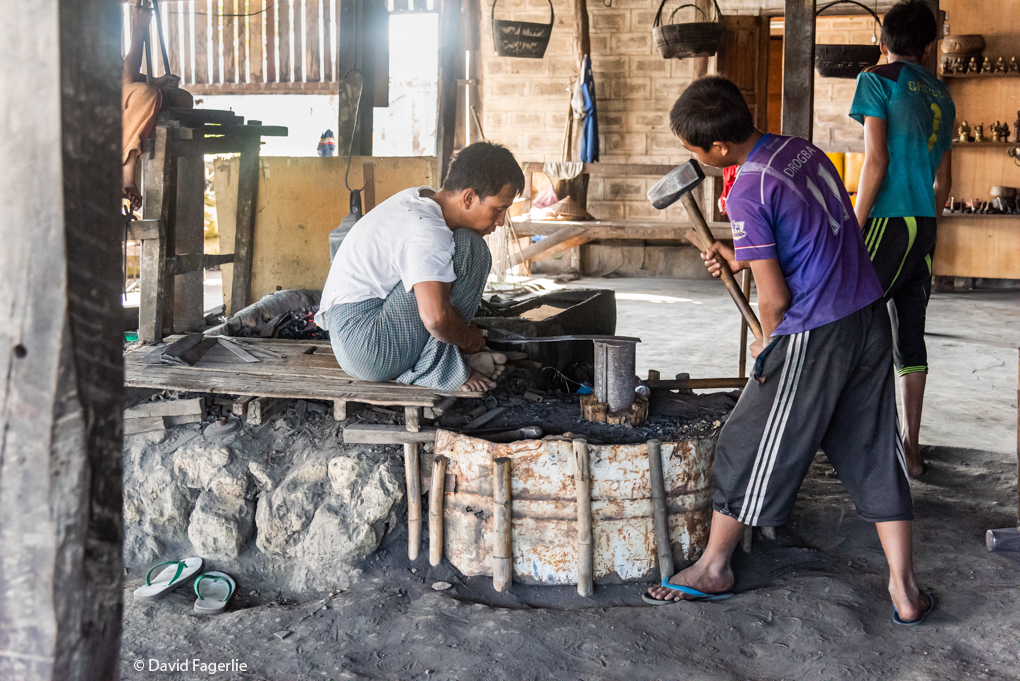
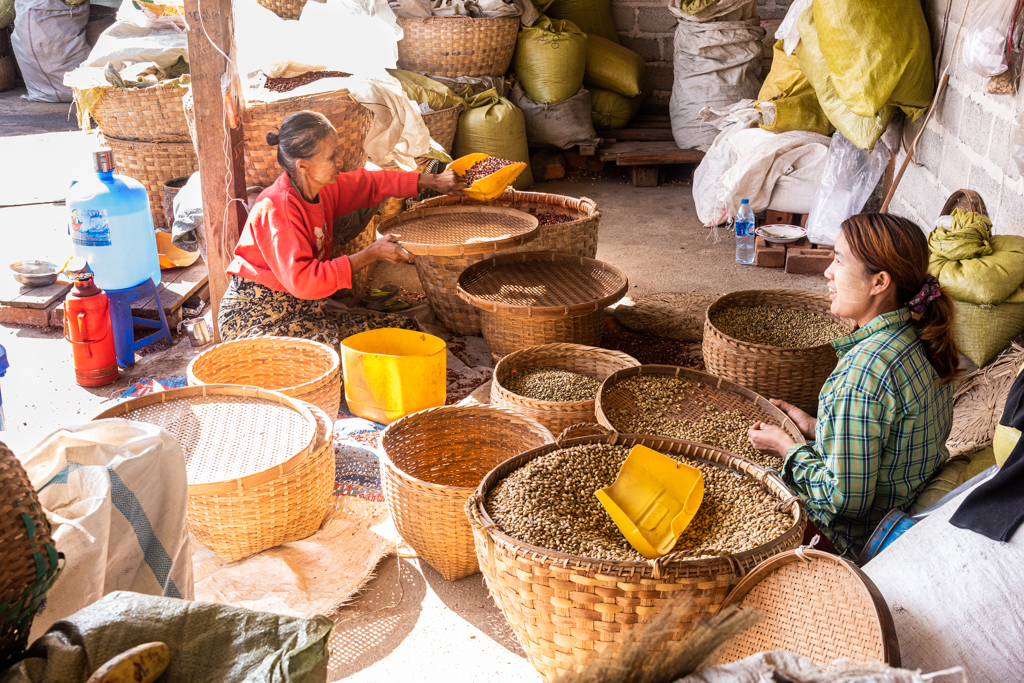
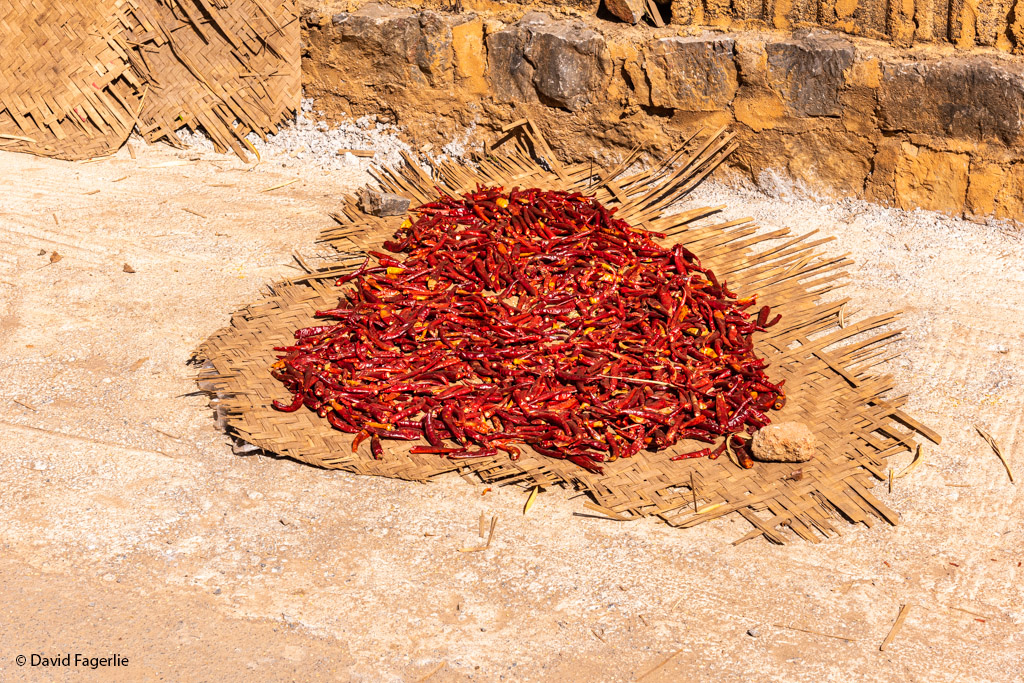
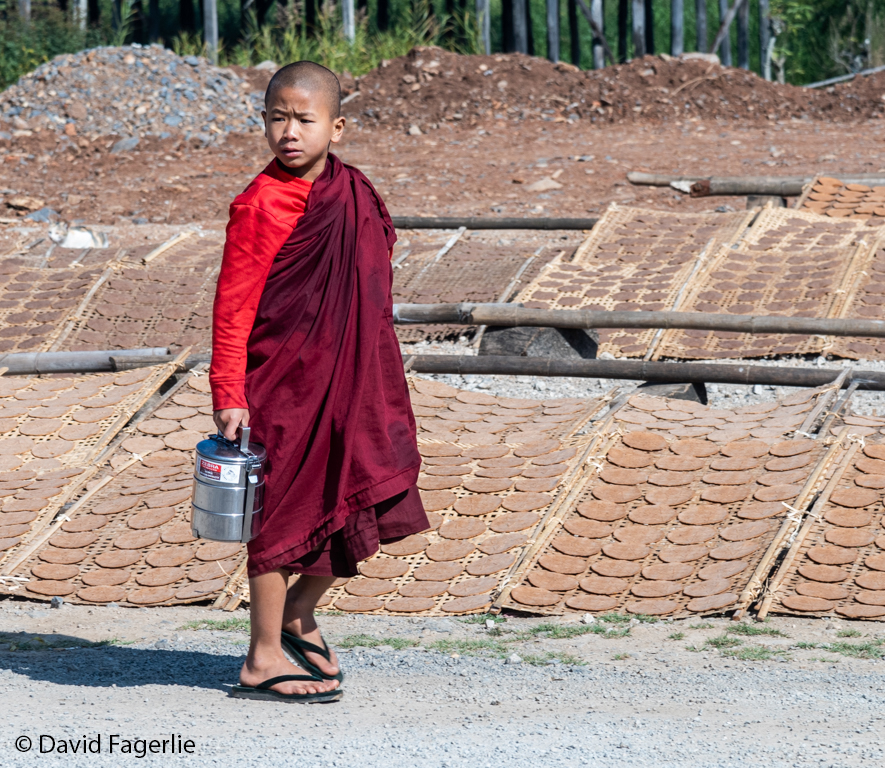
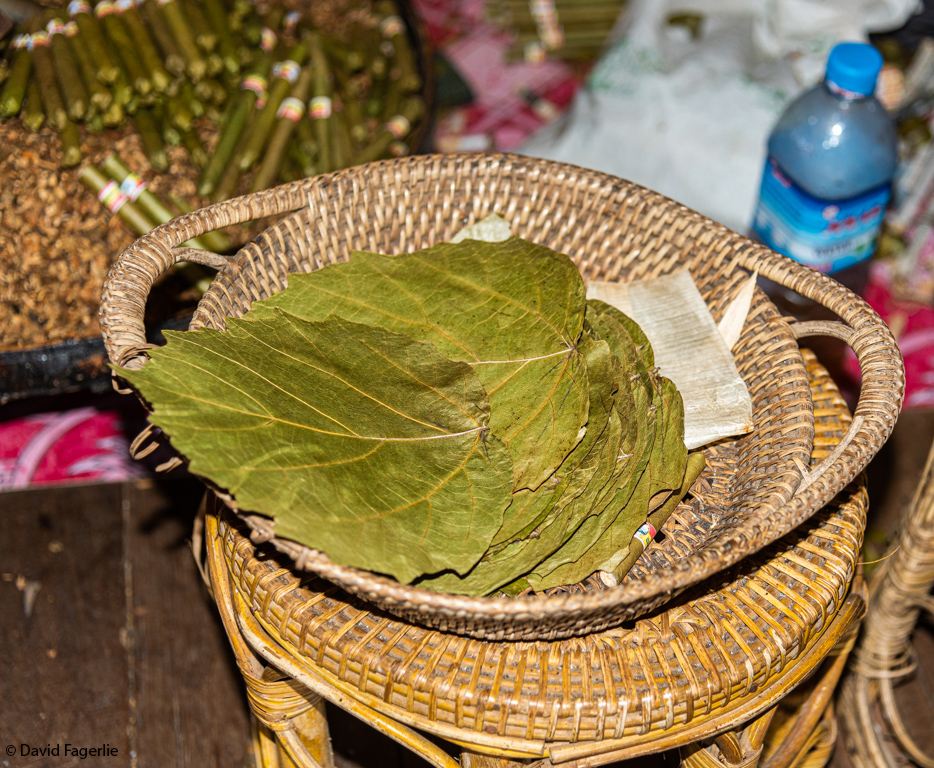
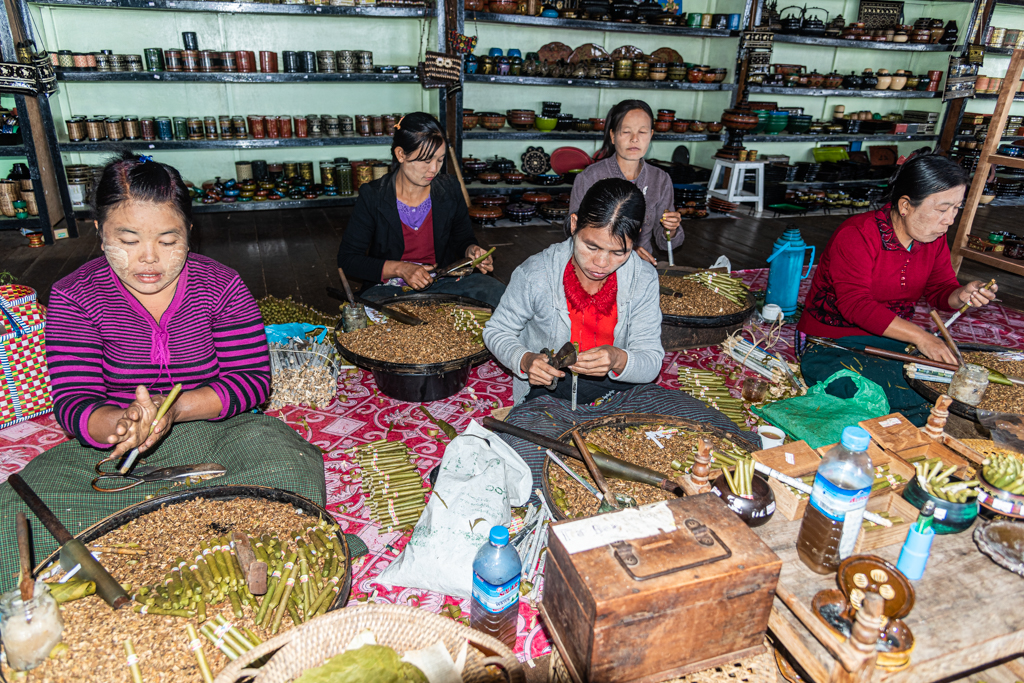
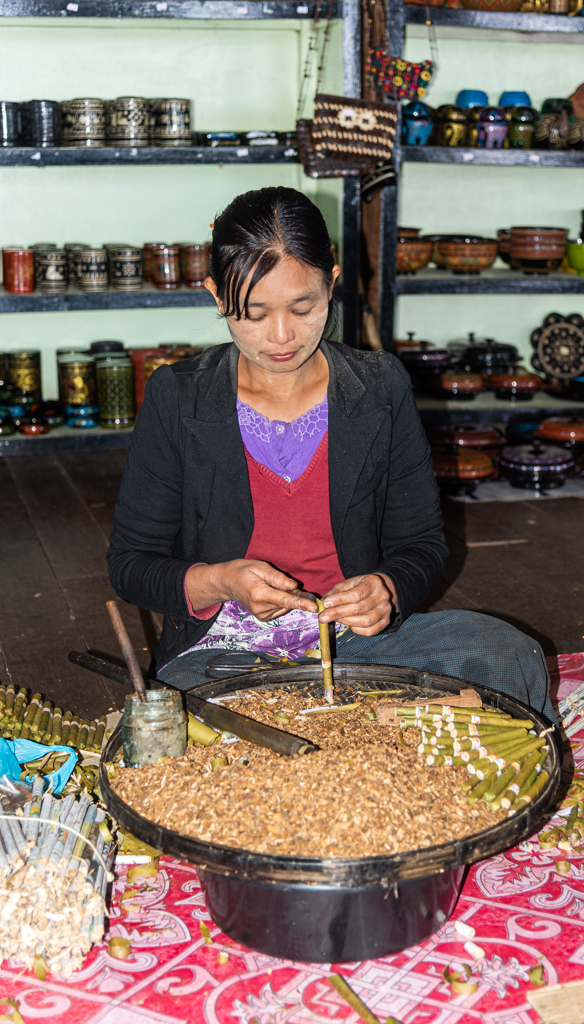
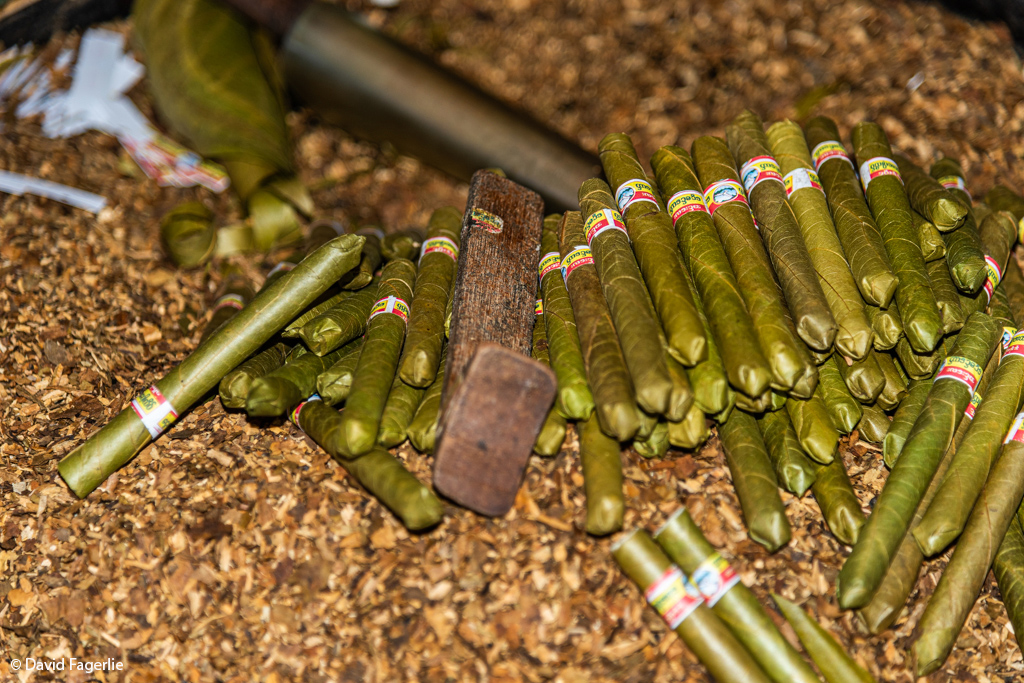
While wandering in the shore community of Kaung Daing I had my first encounter with a Chinese Buffalo. It is a tractor powered by a single cylinder engine. Every bang of a single huge piston is loud and distinct. A Chinese Buffalo has power enough to pull sizable loads at slow speeds.
In the town, I noted with interest that nobody seemed to notice us. We were obviously foreigners; yet, everyone went about their business as though we were invisible. I suppose we were just another of many groups of people from somewhere else that wanted to see their town? We were noticed by the children. Their innocence, and openness to whatever came their way, included interacting with us. I guess children are children no matter where they grow up?
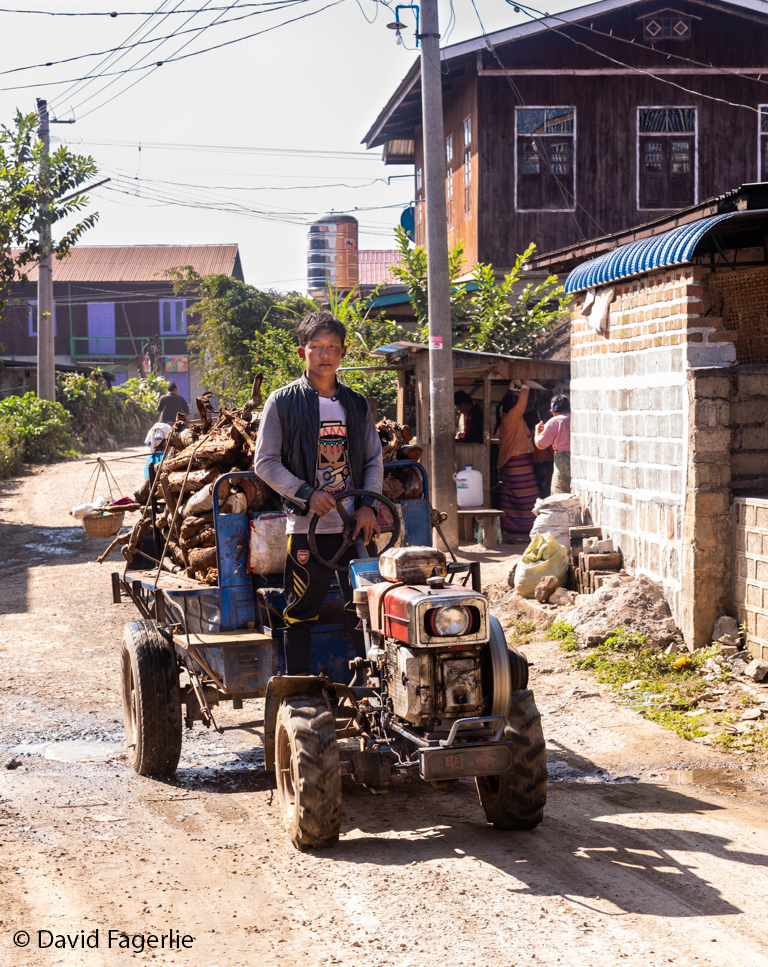
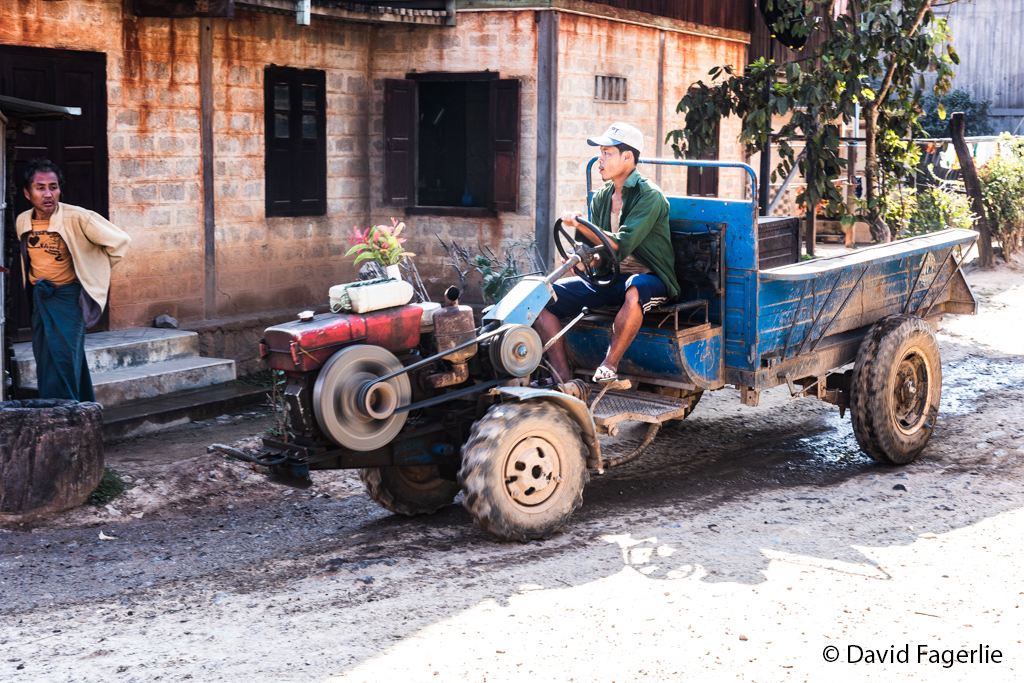
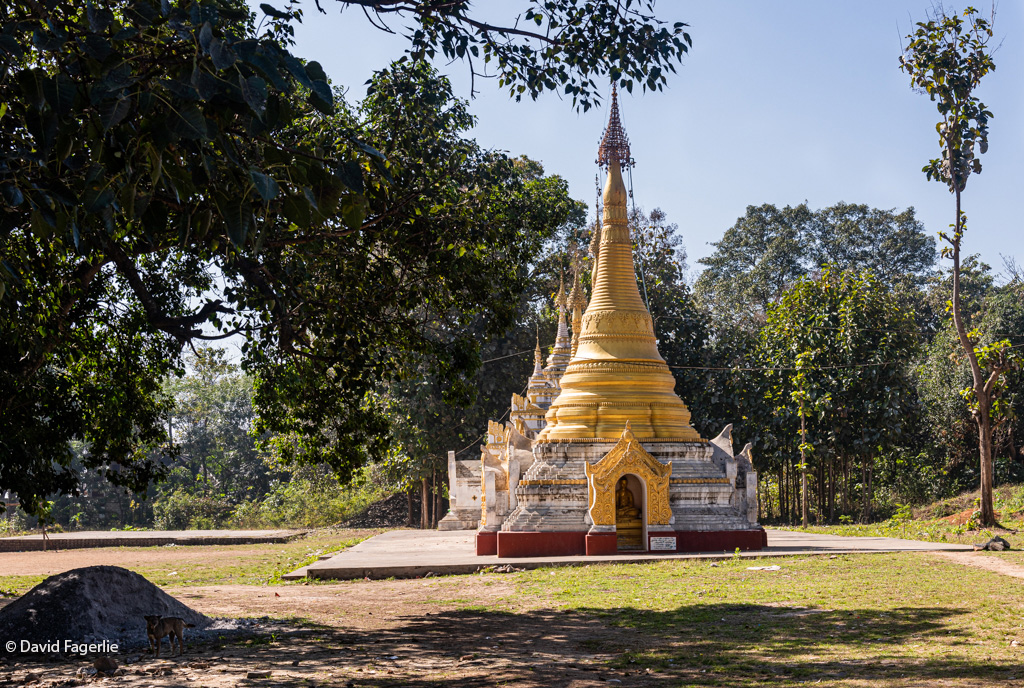
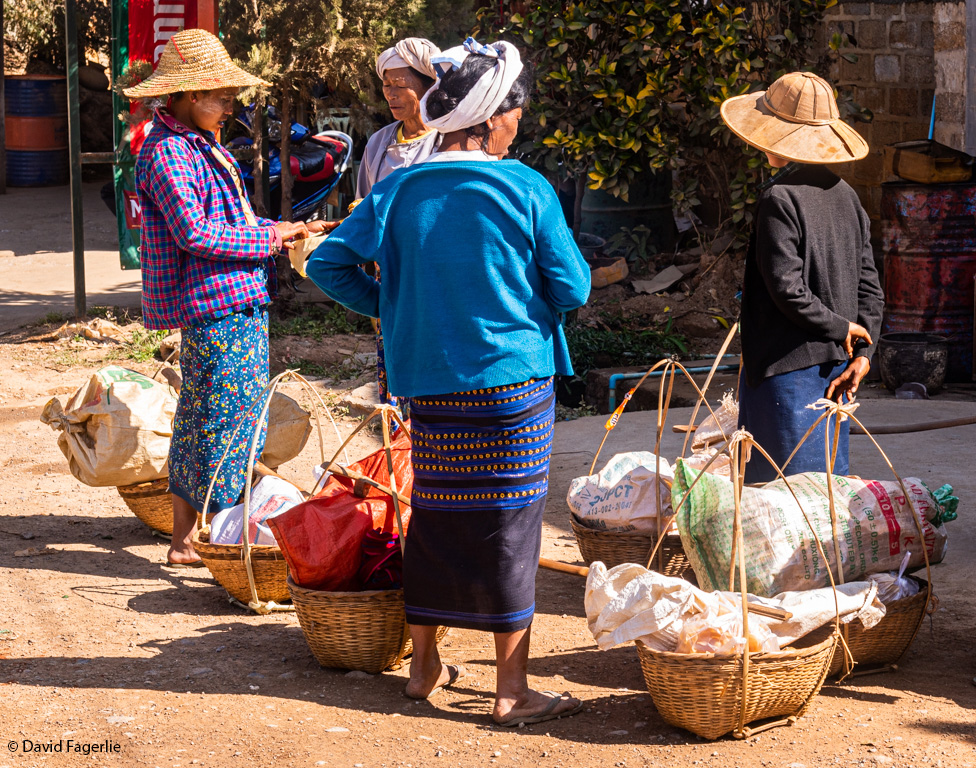
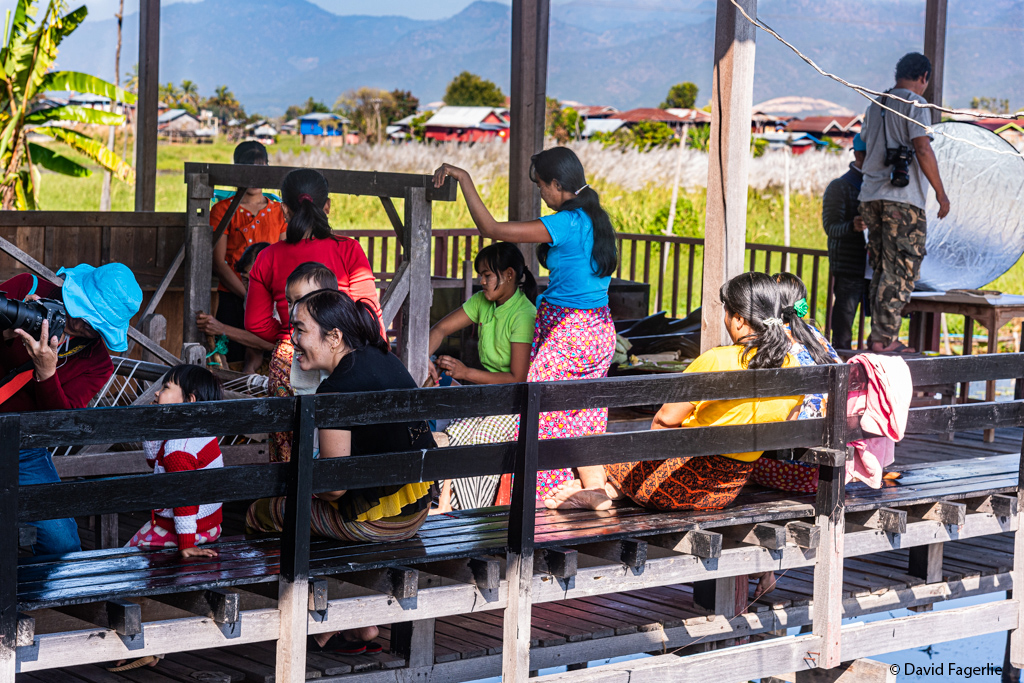
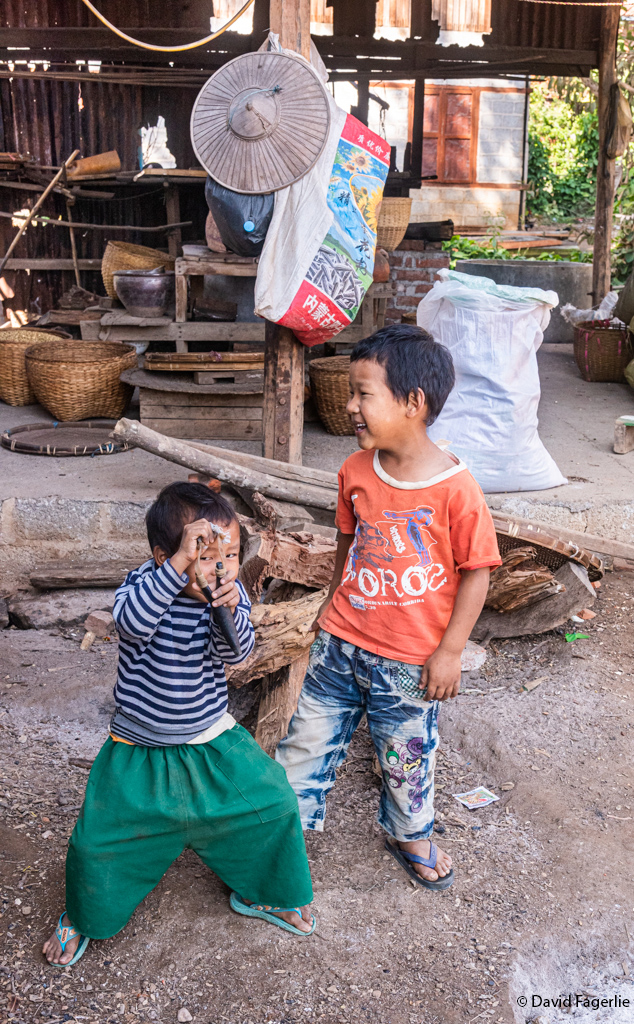
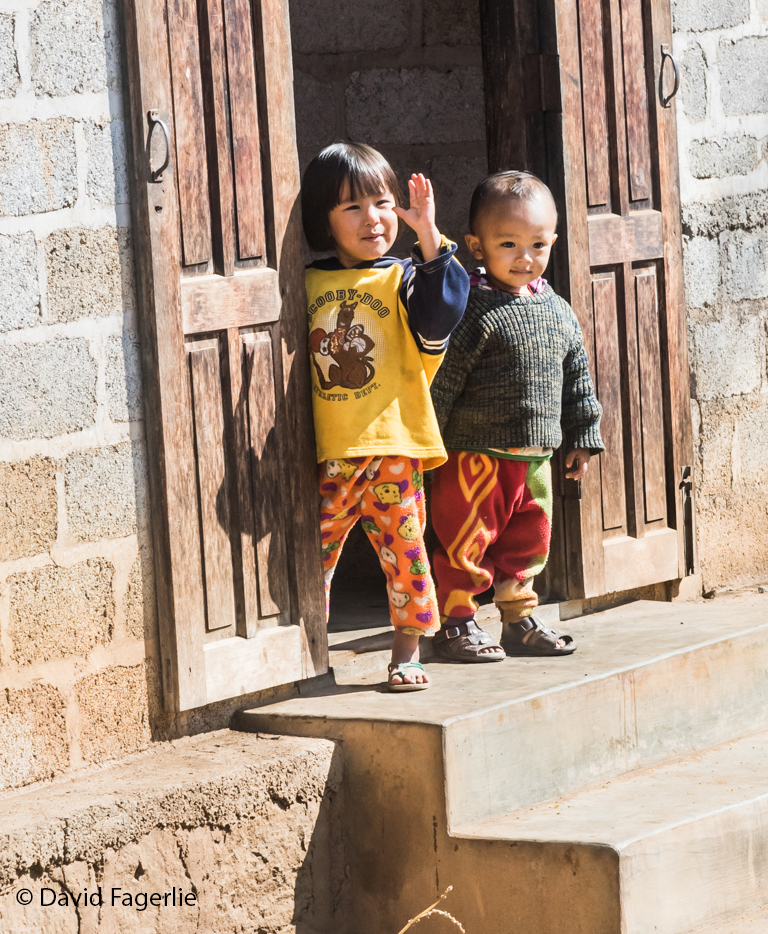
When it was time to depart for Indein, which is inland from the lake, our boat headed south halfway down the western side of the lake, then took a turn upstream on a canal. We saw infrequent evidence of human activity. We passed a primitive wooden bridge and a couple of homes over the canal, one that was full of women having a lively conversation. The further upstream we went the less human activity was evident. The canal weaves a bit and our boatman navigated that with ease, making sure he did not get too close to shores or the boats coming downstream in our direction.
Heading towards Indein I was in the front seat of our boat. Looking ahead, it seemed we were coming to a dam made of bamboo poles pounded into the canal bed that held back a barrier of some kind that was submerged; I guessed there were rocks that the poles held in place with maybe some bindings I could not see? As we got closer our boat maintained its speed and I thought surely we would be turning to a connecting canal I could not see at the moment. About the time that I realized there was nowhere to turn the motor of our boat throttled up and the boat weaved about to reposition as it gained speed. The motor throttled up some more heaving us forward as we got closer to the dam. I could now see a narrow gap that I thought was about as wide as our boat, or less, where there was no bamboo. I held my breath as our boat rammed that spot full speed and vaulted over the hand-made dam into higher water deep enough for our boat but probably not much deeper. Although we hit a succession of these makeshift dams, I held my breath only at the first one. We were fortunate to be able to make this day trip. During the low water months this shallow canal is not passable.
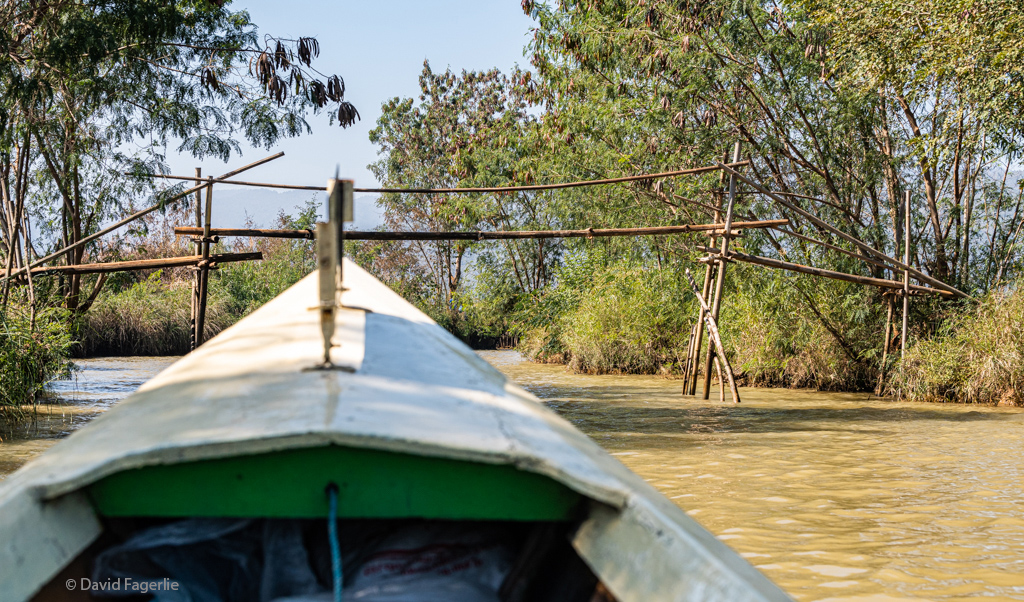
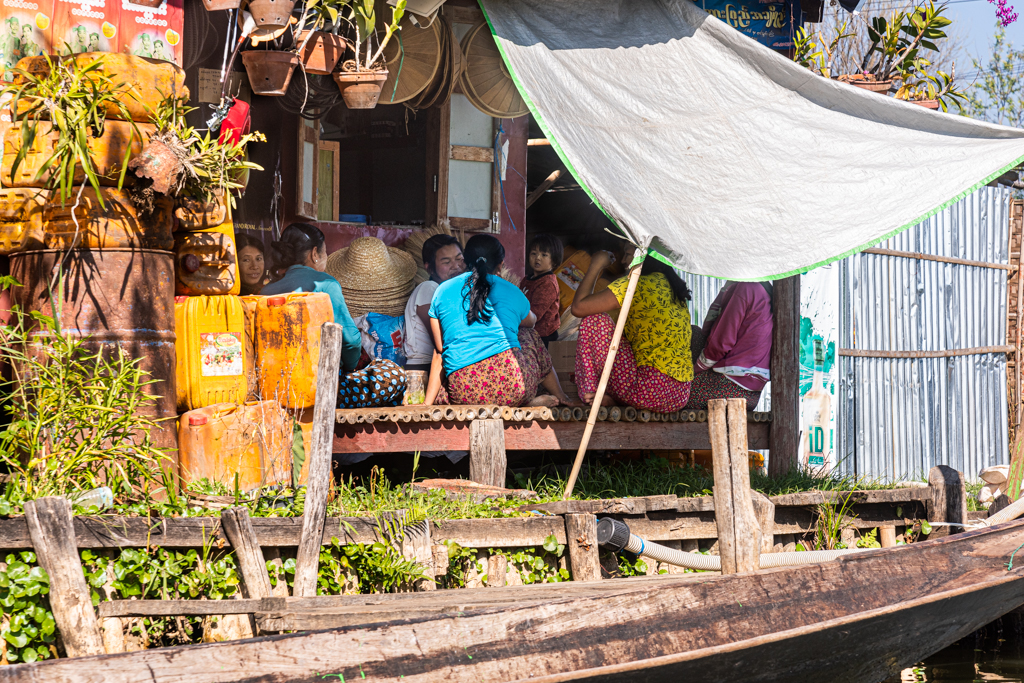
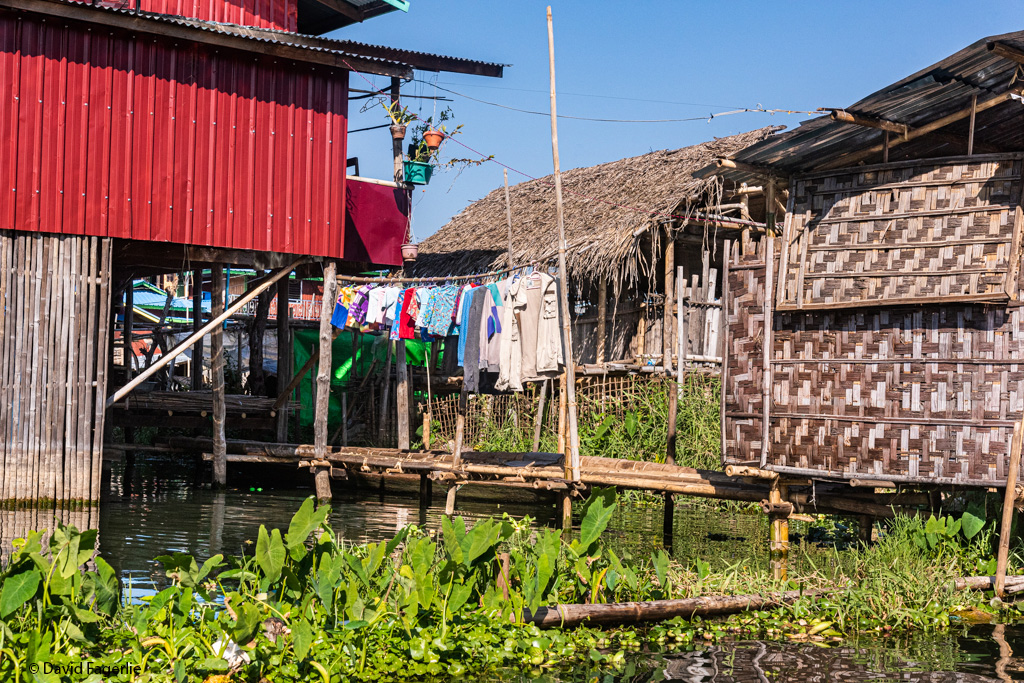
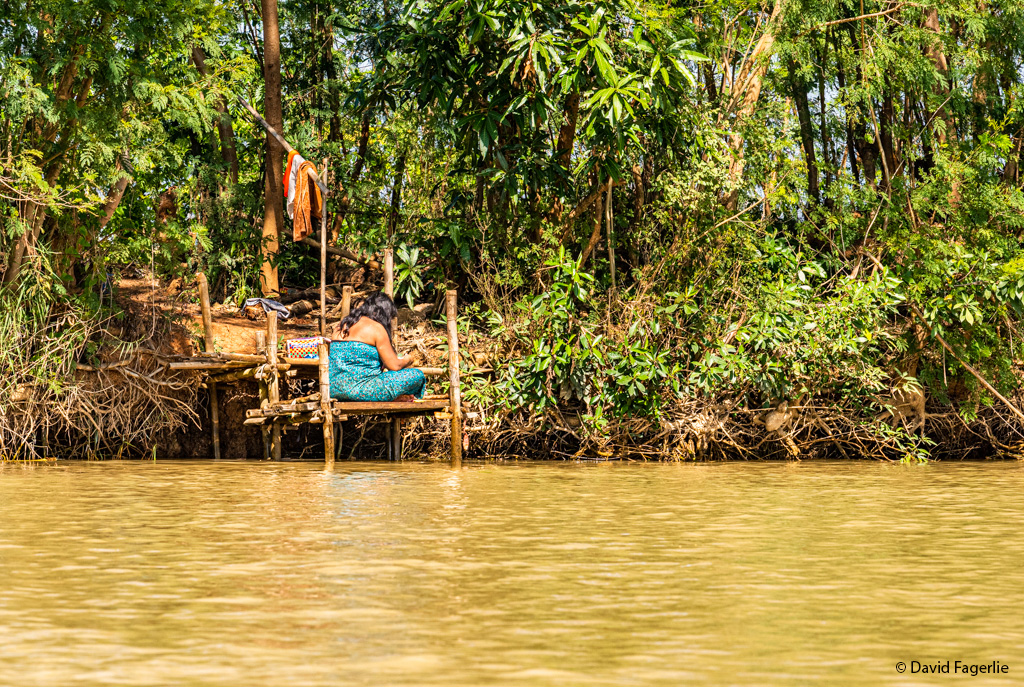
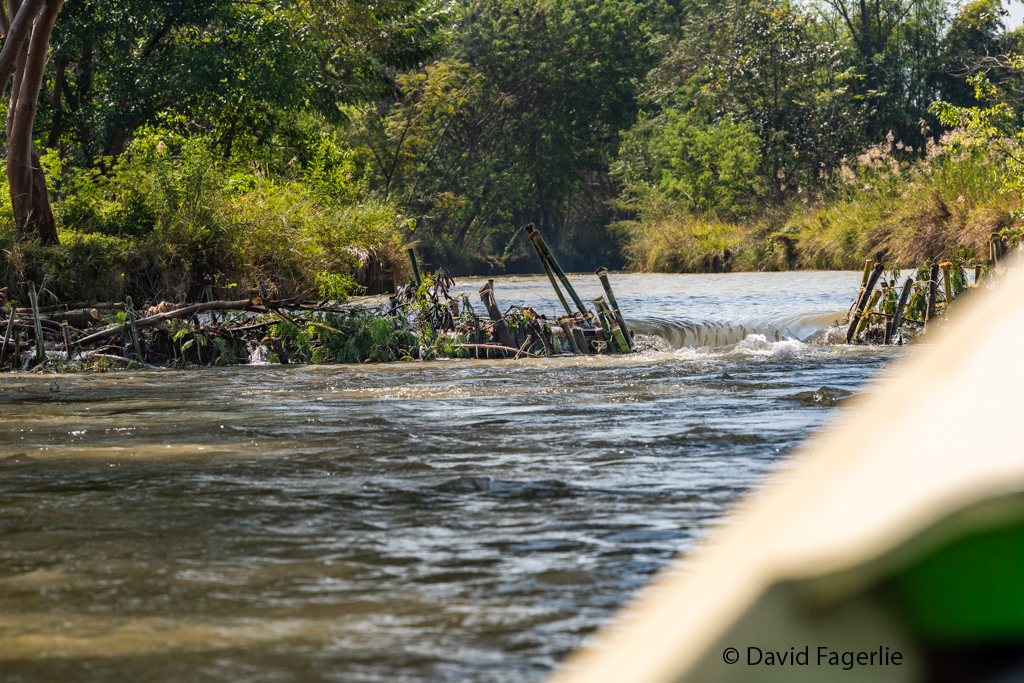
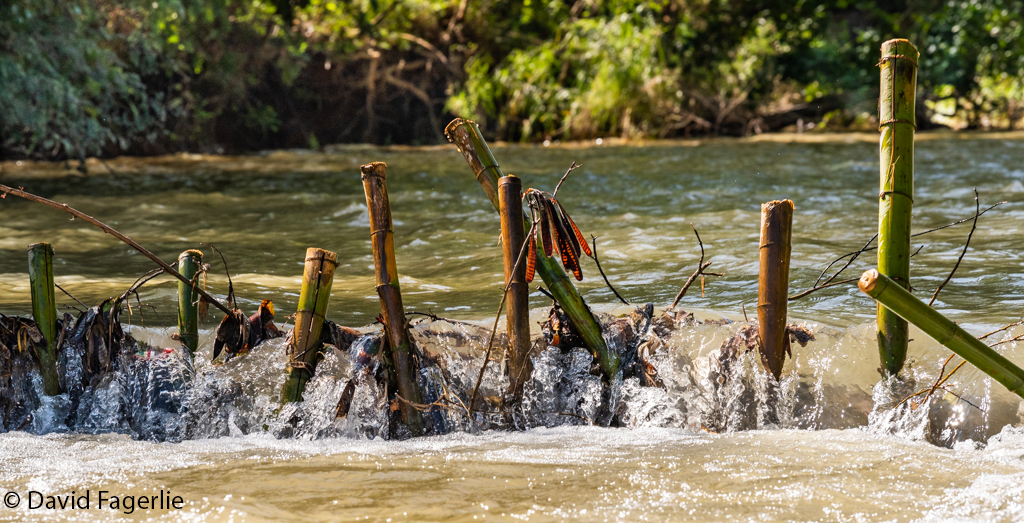
We docked at Indein, a small but energetic community. We had lunch at a nice restaurant. I wondered how many restaurants there might be in this town that was not accessible due to low water for months of each year?
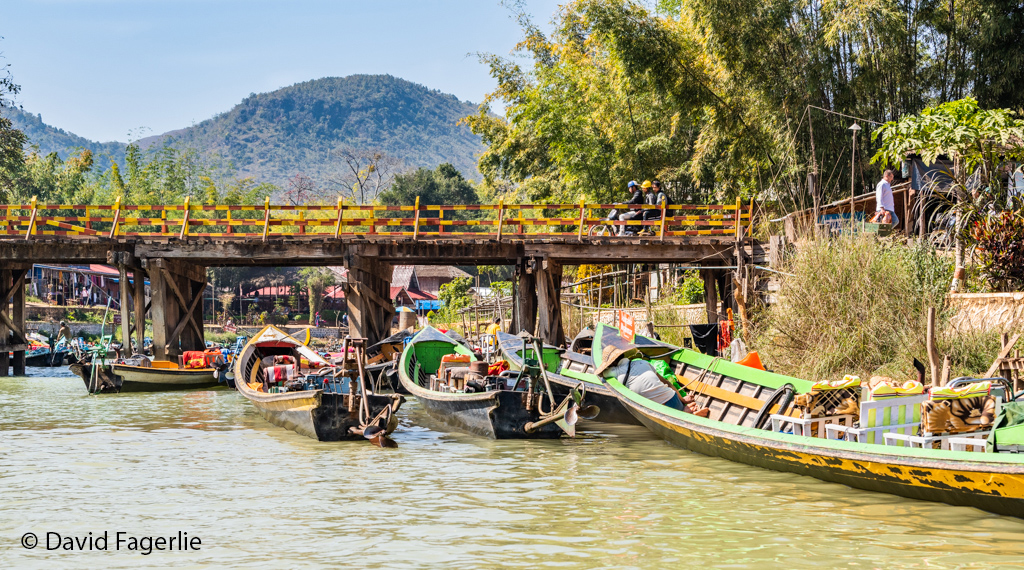
We started walking. In a short time we came across crumbling stupas, some of which had been overtaken by trees creating an artistic expression from human and nature engineering. Some of the archaeological remains at Indein date to the 3rd century when King Ashoka of India dispatched monks to spread Buddhism across Asia. Most of the 1,000-plus pagodas were built in the 11th and 12th centuries. This was one of my favorite sites in Myanmar. There were very few people. I enjoyed being with the historic structures with only the sound of my footsteps and the pleasant sound of my camera’s shutter-release interrupting my solitude.
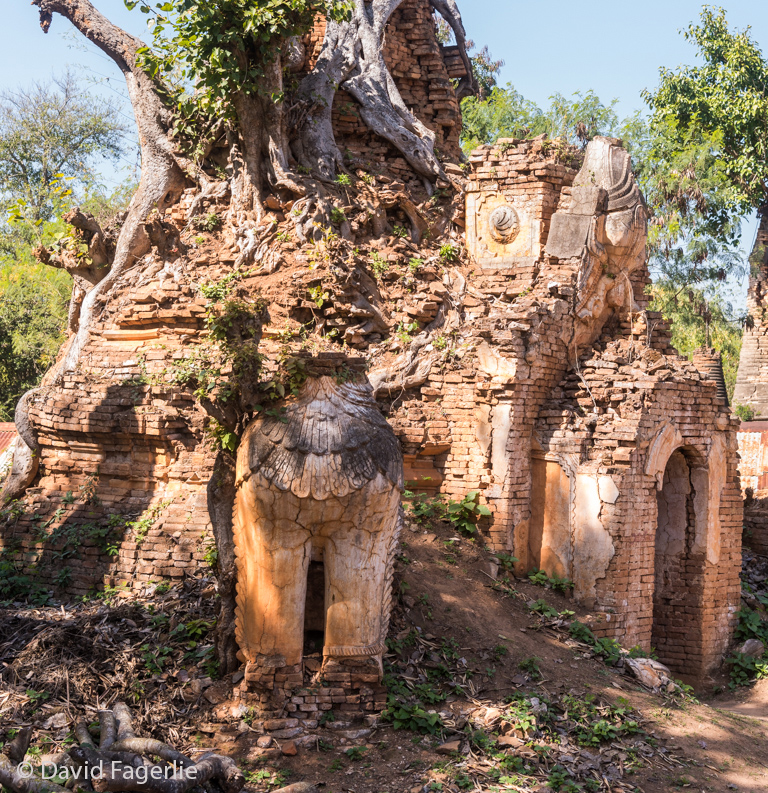
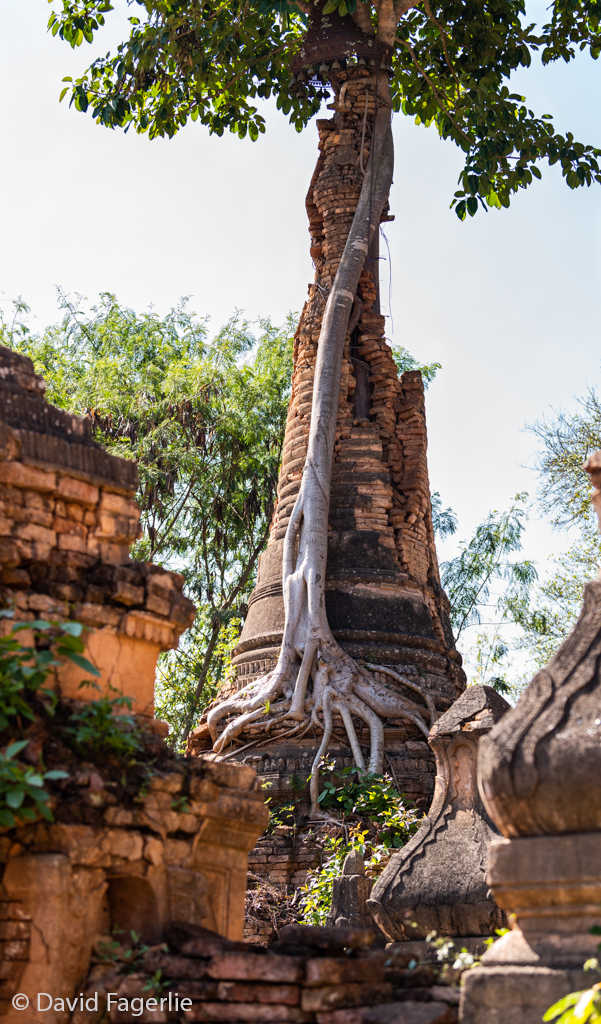
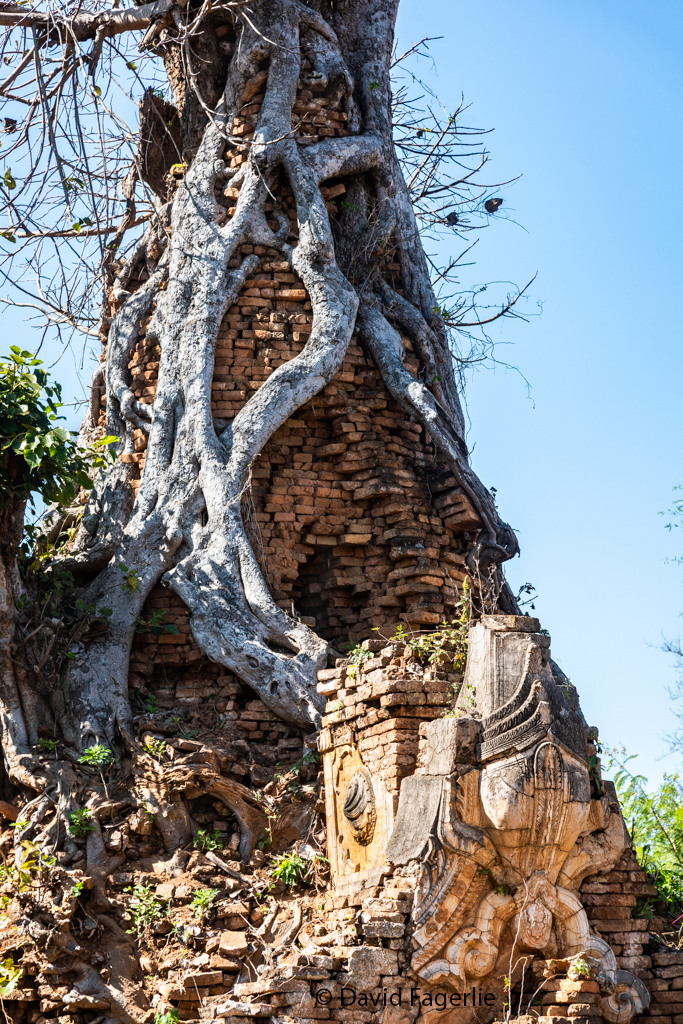
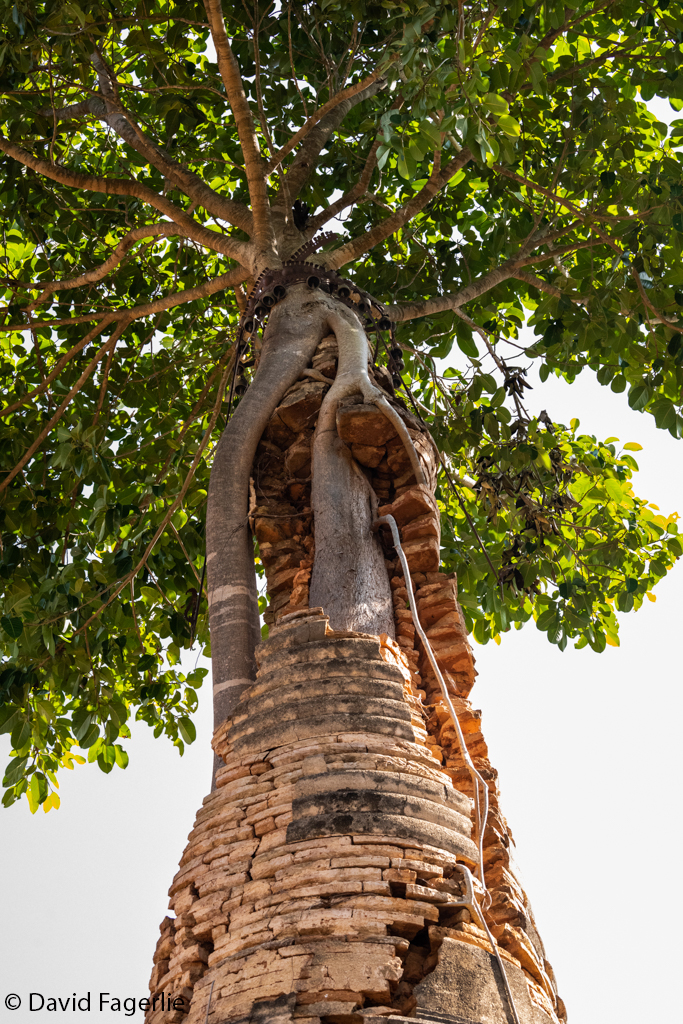
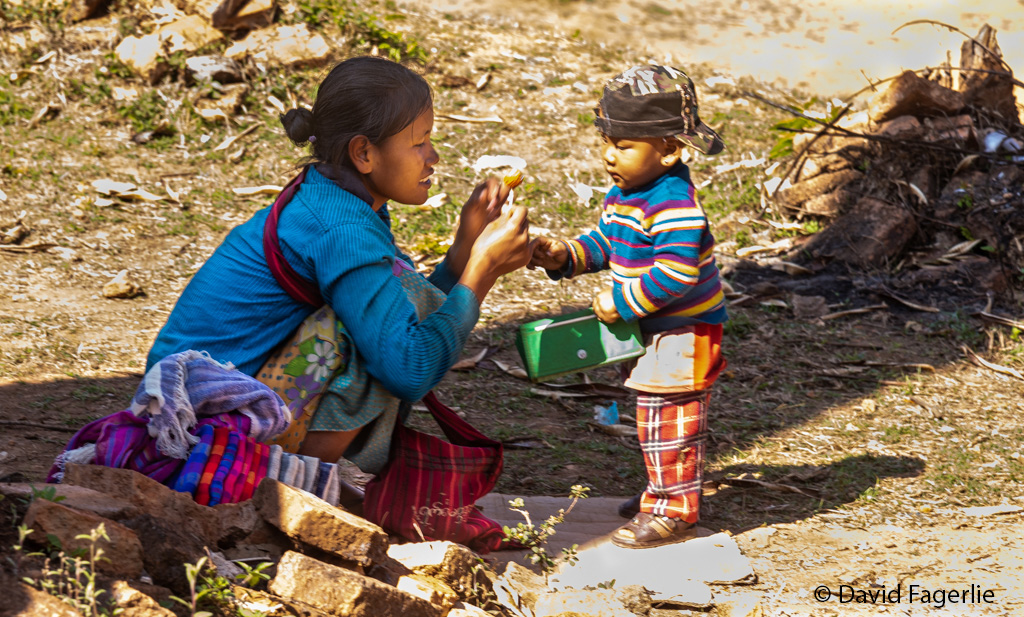

As I penetrated deeper into the historic area the artifacts were in better condition. Some of the stupas were solid core. Many had openings that housed Buddha images. Smaller stupas had very narrow openings that were barely wide enough for a small person to wiggle into. Other stupas were large enough to have rooms I could walk into. In one room a fragment of a Buddha head lay near the room entrance. It captured my interest and my photo of it, the last photo in this chapter, became my favorite of all the photos I took in Myanmar. A photograph is the result of several elements coming together. Light, composition, the ability to manipulate camera settings to get a rich and stable image, and post processing. All that is essential. So is having a little luck; I was lucky that day.
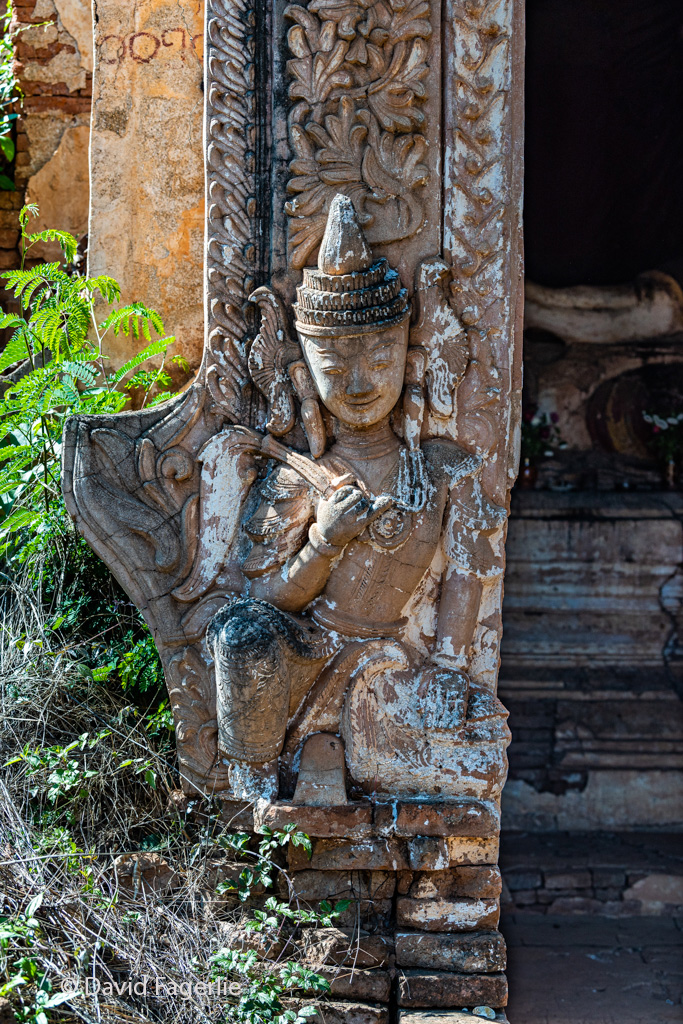
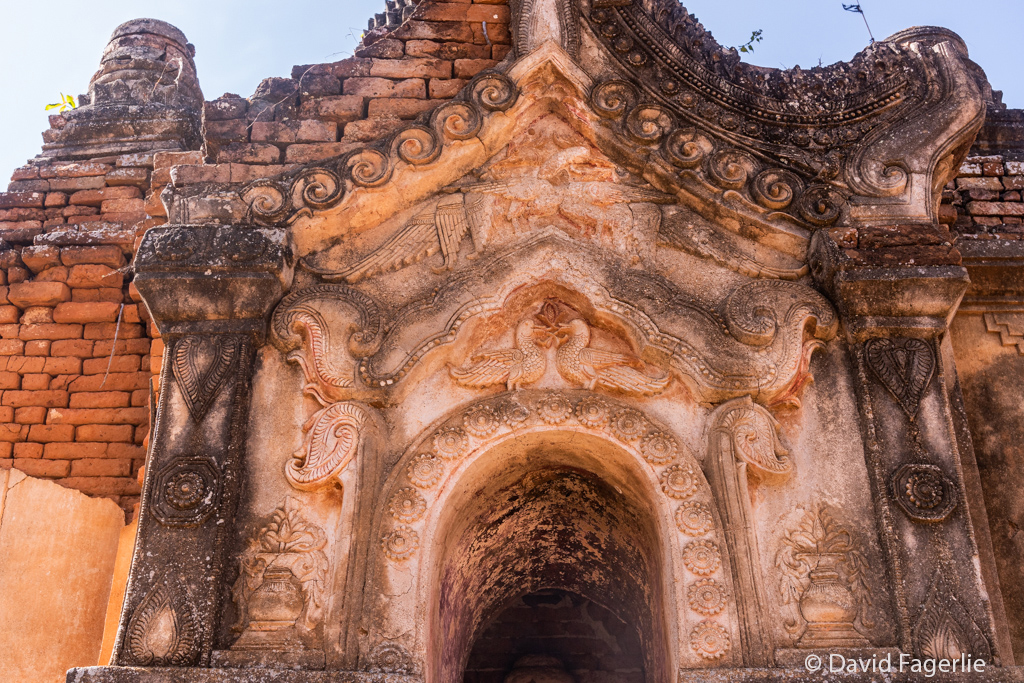
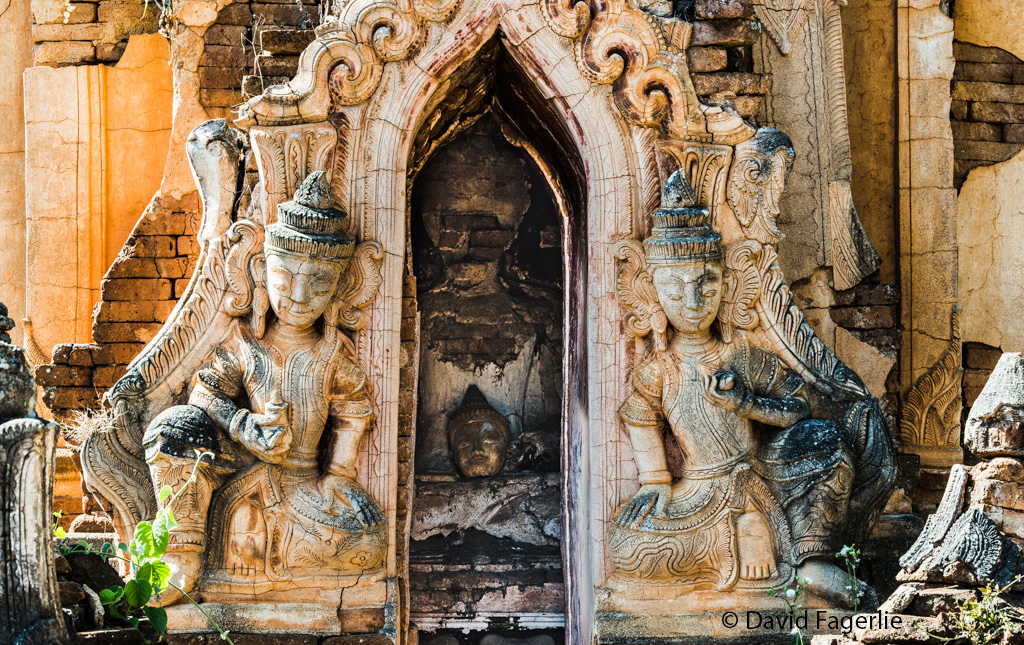
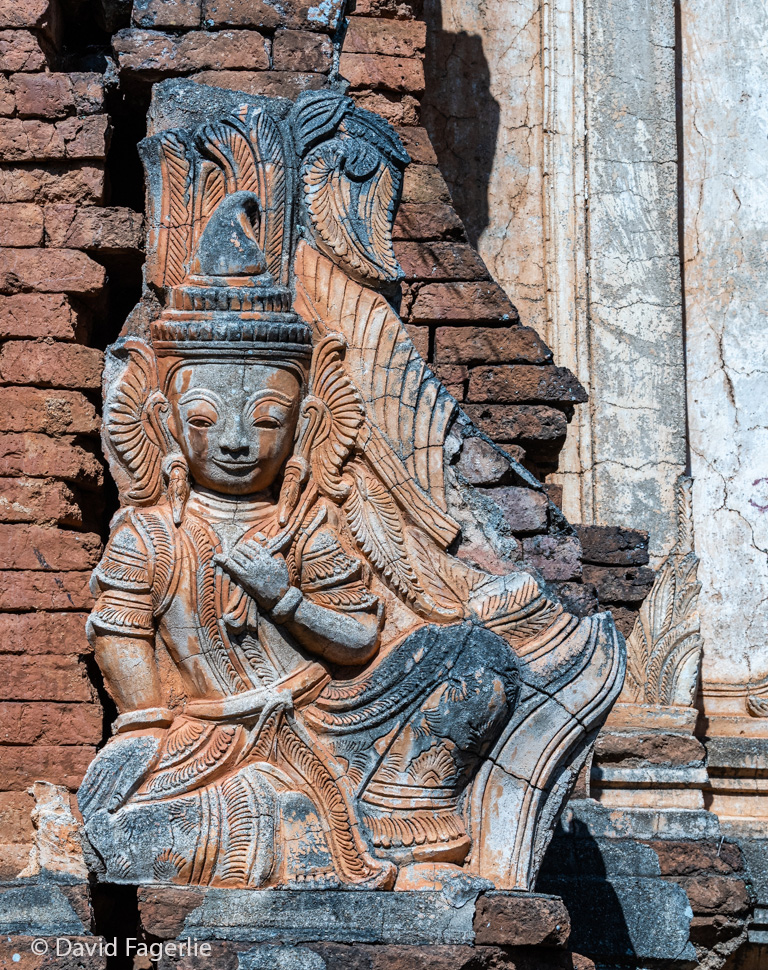
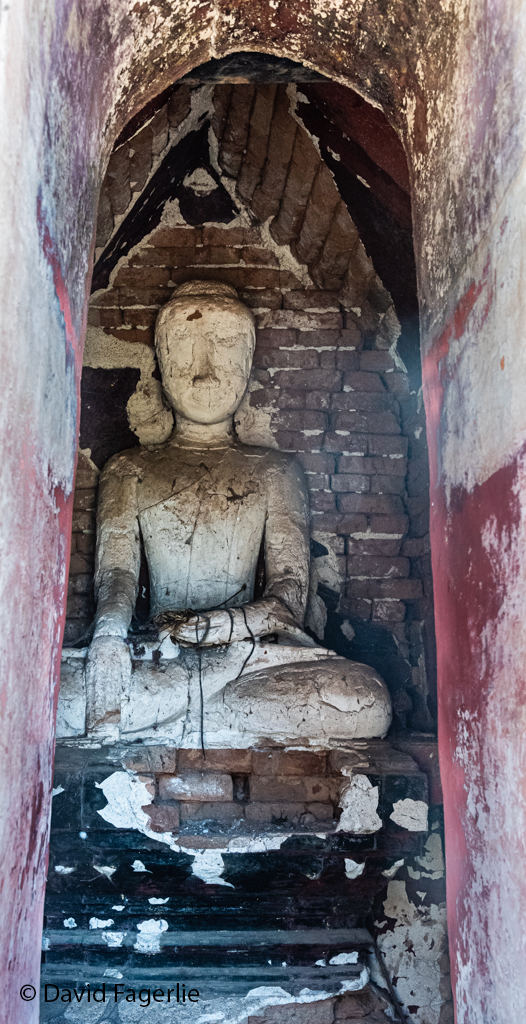
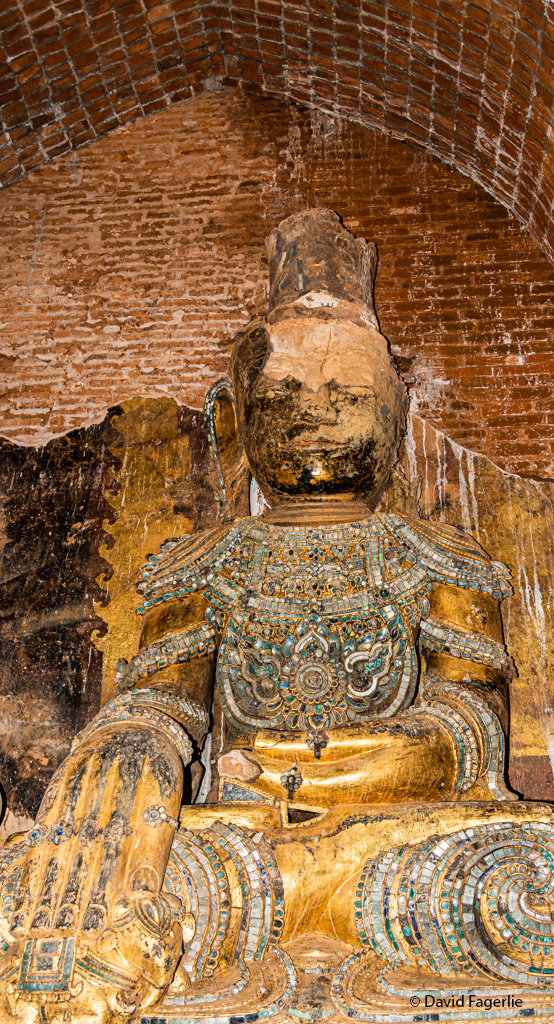
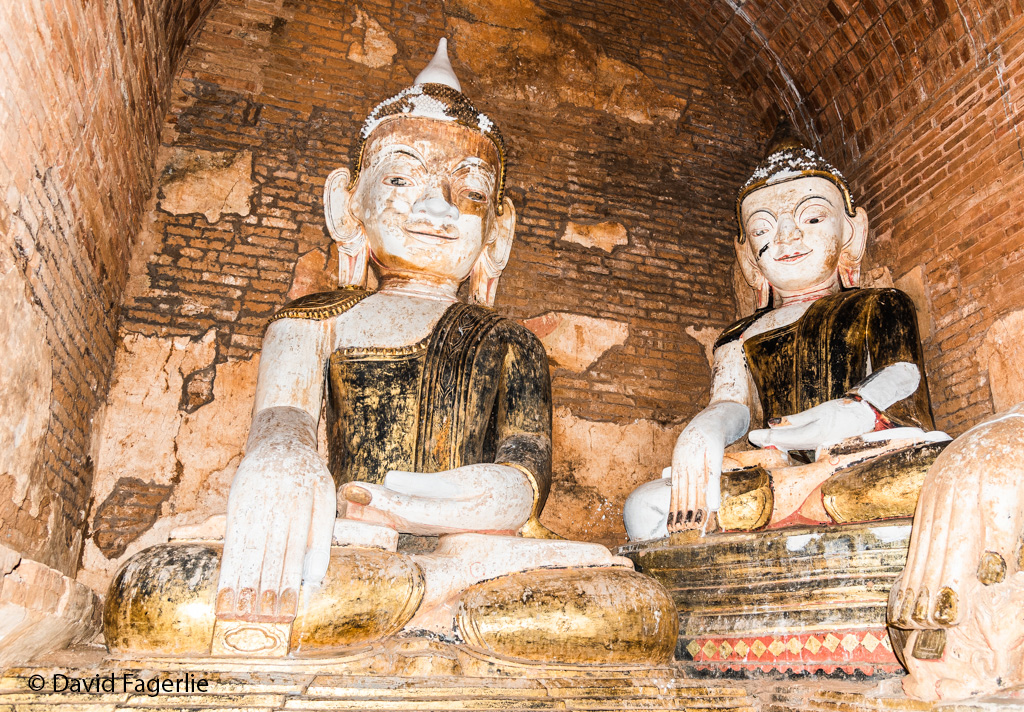
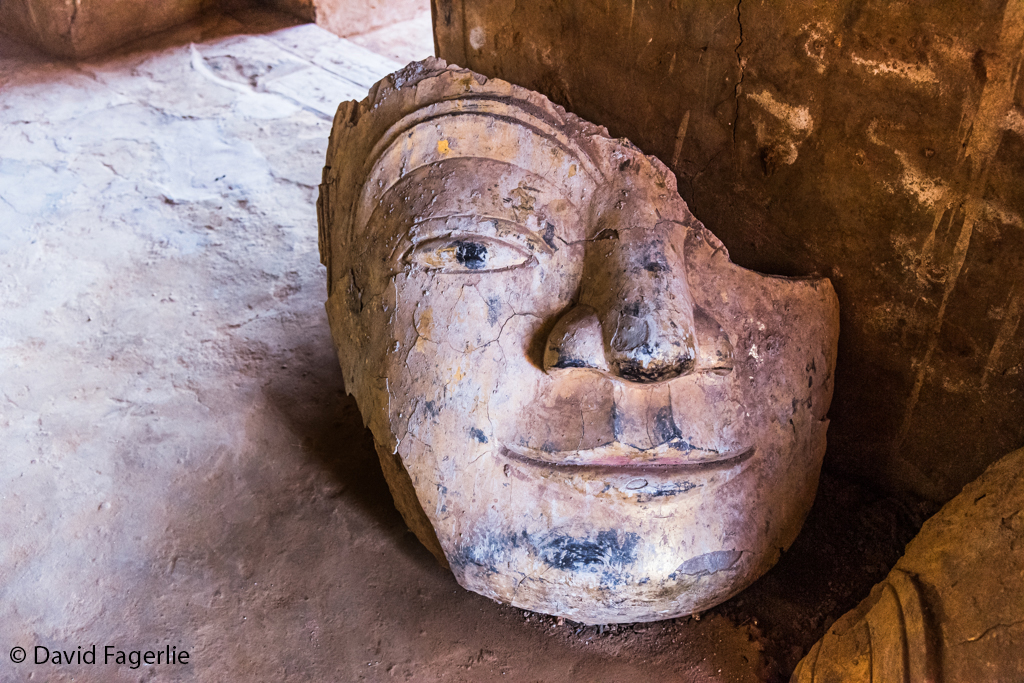
Remember that higher resolution images are available in Galleries. You can access the gallery for this chapter directly by clicking HERE.
Next week we visit Mandalay, our last stop in Myanmar.
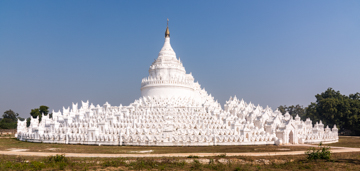
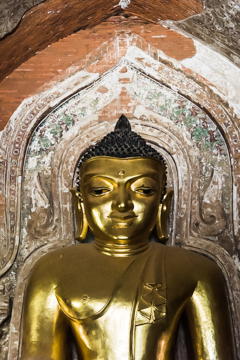
September 16, 2020
Chapter 5: Mandalay
It is the opinion of Asian Historical Architecture that the Shwenandaw Kyaung Monastery “is the most significant of Mandalay’s historic buildings since the ‘Golden Palace Monastery’ remains the sole major survivor of the former wooden Royal Palace built by King Mindon in the mid-nineteenth century.